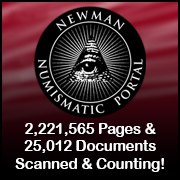
About UsThe Numismatic Bibliomania Society is a non-profit association devoted to the study and enjoyment of numismatic literature. For more information please see our web site at coinbooks.org SubscriptionsThose wishing to become new E-Sylum subscribers (or wishing to Unsubscribe) can go to the following web page link MembershipThere is a membership application available on the web site Membership Application To join, print the application and return it with your check to the address printed on the application. Print/Digital membership is $40 to addresses in the U.S., and $60 elsewhere. A digital-only membership is available for $25. For those without web access, write to: Terry White, Treasurer AsylumFor Asylum mailing address changes and other membership questions, contact Terry at this email address: terrywhite5475@yahoo.com SubmissionsTo submit items for publication in The E-Sylum, write to the Editor at this address: whomren@gmail.com BUY THE BOOK BEFORE THE COINSale Calendar |
- WAYNE'S WORDS: THE E-SYLUM DECEMBER 30, 2018
- NEW BOOK: WWII POW & INTERNMENT CAMP CHITS
- NEW BOOK: VALORES DE LA NACIóN
- BOOK REVIEW: ALEXANDER VATTEMARE
- BOOK REVIEW: NEW HAMPSHIRE MERCHANT SCRIP
- JOHN W. MCCLOSKEY, 1938-2018
- NUMISMATIC TIMEPIECES ON THE NEWMAN PORTAL
- QUERY: BOOSEL'S 2 1/2 CENT COIN CONCEPT
- THE WESTERNER NEWSLETTER
- AN ANALYSIS OF ISIS COIN PRODUCTION
- NOTES FROM E-SYLUM READERS: DECEMBER 30, 2018
- MORE ON THE KP CHRISTMAS SILVER ROUNDS
- THE "WE ALL HAVE OUR HOBBIES" TOKENS
- THE "SMOKING OF THE WEED" TOKEN
- VOCABULARY TERMS: CONTEMPORARY
- JONAS ADLER
- HARVEY STACK'S NUMISMATIC FAMILY, PART 34
- CHICAGO INDUCTS RIPSTRA INTO HALL OF FAME
- ALEXANDER HAMILTON IN NUMISMATICS
- THE 1914 MILLION-DOLLAR ANS COIN EXHIBIT
- PNG ESTIMATES $4 BILLION 2018 U.S. COIN MARKET
- DR. KAVAN RATNATUNGA, ASTRONOMIC NUMISMATIST
- STEPHEN ALBUM SALE 33 JANUARY 2019
- NUMISMATIC NUGGETS: DECEMBER 30, 2018
- CZECH REPUBLIC GOLD COIN FIND
- AMERICAN BANK NOTE BAKER STREET IRREGULARS TRAYS
- MONEY ARTIST JOSH LEIDOLF, AKA TRAN$PARENT
- WSJ: YOUR CASH IS NO GOOD
- LOOSE CHANGE: DECEMBER 30, 2018
- FEATURED WEB SITE: WATERLOO COIN SOCIETY
Click here to access the complete archive a
Click here to unsubscribe (scroll down)
To comment or submit articles, reply to whomren@gmail.com
Content presented in The E-Sylum is not necessarily researched or independently fact-checked, and views expressed do not necessarily represent those of the Numismatic Bibliomania Society.
WAYNE'S WORDS: THE E-SYLUM DECEMBER 30, 2018
 New subscribers this week include: Donnie Bailey. Welcome aboard! We now have 5,816 subscribers.
New subscribers this week include: Donnie Bailey. Welcome aboard! We now have 5,816 subscribers.
Thank you for reading The E-Sylum. If you enjoy it, please send me the email addresses of friends you think may enjoy it as well and I'll send them a subscription (but let me know if they are located in the European Union). Contact me at whomren@gmail.com anytime regarding your subscription, or questions, comments or suggestions about our content.
This week we open with two new book announcements and two reviews.
Other topics this week include the 2 1/2 cent coin concept, an analysis of ISIS coin production, the "Smoking of the Weed" token, Jonas Adler, John McCloskey, J. Henri Ripstra, the Astronomic Numismatist, the famed 1914 ANS exhibit, and money artist TRAN$PARENT.
To learn more about money used by WWII POWs in the U.S., celebrated ventriloquist Alexandre Vattemare, New Hampshire merchant scrip, numismatic timepieces, The Westerner newsletter, George Walton's collection, the $4 billion U.S. coin market, and everywhere your cash is no good, read on. Have a great week, everyone!
Wayne Homren
Editor, The E-Sylum
NEW BOOK: WWII POW & INTERNMENT CAMP CHITS
The Coin & Currency Institute issued this press release on a new book about WWII POW & Internment Camp Chits used in the United States. -Editor
Groundbreaking New Book on the Money Used by World War II Prisoners of War in the United States
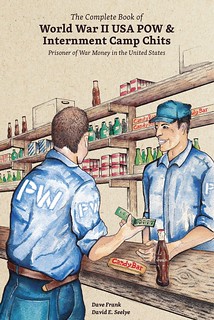 It is an often forgotten piece of World War II history that between 1942 and 1946, 425,000 Germany, Italian, and even some Japanese prisoners of war were held at 700 POW
camps in 46 U.S. states. All except the Japanese got here on troop transport ships that would have otherwise returned from Europe empty. A new book, The Complete Book of World
War II USA POW & Internment Camp Chits. Prisoner of War Money in the United States, by Dave Frank & David E. Seelye, is a comprehensive look at one of the overlooked,
yet more intriguing aspects of the camps' operations – the money, or “chits” that the POWs used for discretionary expenses in their camps, such as for cigarettes, candy, paper
and postage, 3.2% beer, or other items.
It is an often forgotten piece of World War II history that between 1942 and 1946, 425,000 Germany, Italian, and even some Japanese prisoners of war were held at 700 POW
camps in 46 U.S. states. All except the Japanese got here on troop transport ships that would have otherwise returned from Europe empty. A new book, The Complete Book of World
War II USA POW & Internment Camp Chits. Prisoner of War Money in the United States, by Dave Frank & David E. Seelye, is a comprehensive look at one of the overlooked,
yet more intriguing aspects of the camps' operations – the money, or “chits” that the POWs used for discretionary expenses in their camps, such as for cigarettes, candy, paper
and postage, 3.2% beer, or other items.
Why did prisoners of war have or even need money? Enlisted POWs, the book explains, were allowed to work on non-military tasks such as farming, construction, and manufacturing. For this, they were paid on a scale based on the U.S. equivalent of their military rank. A private in 1941, as an example, got 80 cents a day and an additional gratuitous 10 cents per day for necessities. Officers got paid if they worked or not. If they chose to, they got paid extra. Many POWs returned home wealthier than the families they left behind when they went off to war. Some of the pay could be used to purchase canteen coupons in the form of booklets with face values of from 20 cents to $20 that could be used in the camp.
Rather than employing a unified payments system, the camps issued their own ticket-like chits in booklets prepared under contract by private printers. The first accounting of these chits was in Die Kantinenschecks der Deutschen Kriegsgefangenen in den U.S.A., written in 1953 by Albert Pick, himself a former German POW, who would go on to become a legend in world paper money. A few other books followed, the last over twenty years ago. The Complete Book of World War II USA POW & Internment Camp Chits, by Messrs. Frank and Seelye, both recognized experts on the topic, has been years in the making, and is by far the most comprehensive work ever done on the subject.
The book contains brief histories for most of the camps, and even some anecdotes. (One of the more amusing ones concerns a days-long protest by German POWs in Nebraska over a delay in a shipment of beer, over which they were already aggravated because of the low alcohol content.) Chits and the booklets they came in are illustrated in color. Prices are given in used and new conditions with a new numbering system devised by the authors. Historical maps, documents, and photographs are interspersed throughout.
For those who don't collect them, this is a book that could make them want to start. Its a fascinating view of an overlooked part of U.S. numismatic heritage. It has 256 6x9 inch pages and over 900 photos.
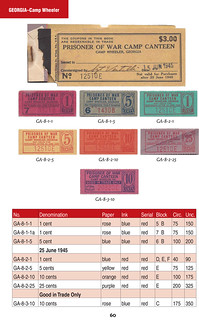
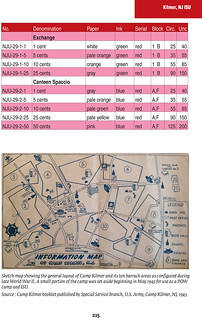
The Complete Book of World War II USA POW & Internment Camp Chits (ISBN 978-0-87184-404-0) is available at $39.99 or may be ordered from book stores, coin and paper money dealers, and from internet book sellers. An E-book version (ISBN 978-0-87184-006-6) is $19.99. Copies may also be obtained from the Coin & Currency Institute, P.O. Box 399, Williston, Vermont 05495. $5.75 should be added to each order for shipping and handling. Major credit cards are accepted. Call toll-free 1-800-421-1866. Fax (802) 536-4787. E-mail: mail@coin-currency.com . Preview sample pages at www.coin-currency.com .

NEW BOOK: VALORES DE LA NACIÓN
Cedrian López-Bosch submitted this information about a new book on an interesting Mexican government hoard of banknotes and bonds. Thank you! -Editor
 I wanted to share with your readers a book published by Mexico's Ministry of Finance, in which I had the pleasure to contribute (available only in Spanish):
I wanted to share with your readers a book published by Mexico's Ministry of Finance, in which I had the pleasure to contribute (available only in Spanish):
Few years ago, at the Ministry of Finance's printing facilities someone asked to empty a room to be able to store either passports or stamps that are normally printed there. The response was that the objects there did not belong to this office, but to the Federal Treasury. They asked the latter to empty such room and this story begins:
Apparently the Treasury had forgotten about this vault with thousands of stocks & bonds, and few boxes and bags of banknotes under their custody.
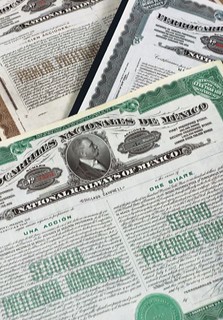
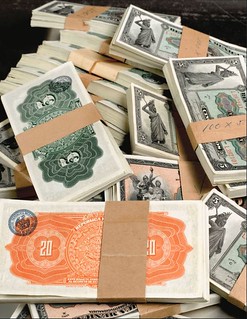
The MoF hired an expert on economic history, to make an inventory and find out what was about, and she kindly invited me to study the banknotes. This repository had nothing rare, but the size and variety of the collection was worth studying, and the MoF decided to publish a book in order to reveal the contents of this collection and invite scholars to further study it.
This is the book that resulted from such project. The first article describes the contents of the collection, putting in context the emissions of private and public debt throughout a century, from late 19th to late 20th Century. In the second article, I tried to describe the different roles played by the MoF around banknotes issuance, from authorization, validation, surveillance, custody, printing, exchange, withdrawal to their destruction throughout the story of this means of payment in Mexico, illustrated with samples of this collection, mainly comprised by notes from the revolution, including hundreds of UNC bundles. Finally, the last article written by the editor, shows how banking architecture, displayed in several banknotes in the late 19th Century showed the richness and economic wealth of those times.
What a great opportunity to rediscover a forgotten treasure! It's a sumptuously illustrated book, in full color. I went overboard in choosing sample pages for illustration here. The complete book is available online at the link below. -Editor
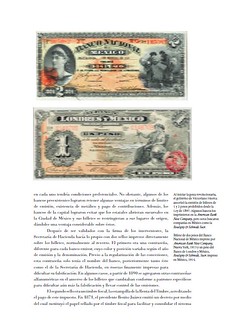
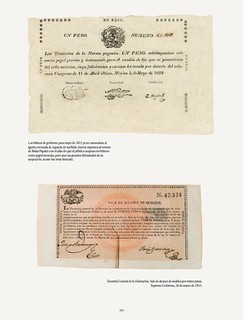
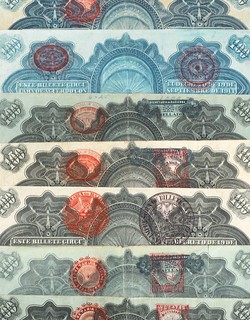


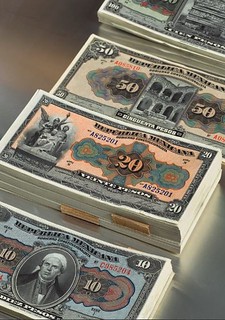
To read the complete book, see:
https://bpo.sep.gob.mx/#/recurso/6406/document/1
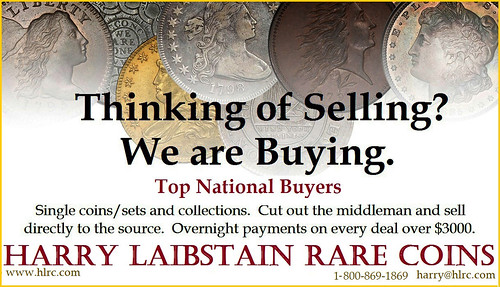
BOOK REVIEW: ALEXANDER VATTEMARE
Dave Bowers has published a new monograph on one of the founding fathers of the numismatic discipline in America, Frenchman Alexandre Vattemare. Dennis Tucker submitted this review. Thanks! -Editor
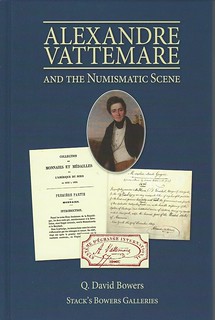 Title: Alexandre Vattemare and the Numismatic Scene
Title: Alexandre Vattemare and the Numismatic Scene
Author: Q. David Bowers
Contributor: David Gladfelter
Publisher: Stack's Bowers, 2018
ISBN: 0988740362, 9780988740365
Length: 96 pages
Alexandre Vattemare was quite the character and personality. He lived two lives, and was famous in both. However, few people in the 1820s through the 1850s, when he was most active, knew they were the lives of a single man. Q. David Bowers explores this juxtaposition in a fascinating new book, Alexandre Vattemare and the Numismatic Scene, which, in addition to those two lives of this rare individual, also lays out Vattemare's importance in the world of coins and medals.
Most popularly, early in his career, Vattemare was known as an entertainer, “Monsieur Alexandre,” a celebrated ventriloquist who performed around the world, including before the crowned heads of Europe. In his youth he had trained as a surgeon, but his voice-throwing shenanigans once kept him from a medical diploma: apparently it wasn't kosher to make cadavers speak during dissection.
On the other hand, later in life (building from the wealth he accumulated as a performer), Vattemare was a champion of public libraries and the international exchange of material culture between libraries and museums. He saved many institutions from throwing away vast treasures or unknowingly allowing them to molder unappreciated. One of many examples Bowers gives: in Albany, Vattemare found a room knee-deep in old historical documents of New York State, reminiscences of British colonists, and similar papers. These were potentially doomed to be used as filler to pack books for shipping! Instead Vattemare recognized their value and, through his encouragement, they were properly preserved and cataloged for posterity.
Alexandre Vattemare could have misused his deep knowledge to plunder neglected collections for his own enrichment. Instead he spent decades as a philanthropist, lobbying for education and intercultural exchange. He pushed tirelessly for the organization of America's disorganized libraries and state archives, and for duplicate books and historical specimens to be exchanged in particular between institutions in the United States, his native France, and Canada. Librarians today revere him as a main figure in the founding of the Boston Public Library.
Days before John Quincy Adams died on February 23, 1848, the ex-president was about to officially endorse Vattemare's literary-exchange programs. He was carrying a paper of his endorsement when he had a stroke on the floor of the House of Representatives.
Bowers has explored the existing historical record on Vattemare, which includes local newspapers from the 1800s, public documents, official letters, legislation, and other such sources. He doesn't rely too heavily on conventional wisdom—which, in the numismatic world, often includes the musings and meanderings of the late Walter Breen. Bowers notes that Breen included many comments about Vattemare in his Complete Encyclopedia of United States and Early American Coins (1988), but that most of them were speculative. (One sample three-sentence passage from Breen includes the words probably, may account for, and might have.) “Any and all Breen information must be verified elsewhere,” Bowers notes.
As he does in all his research, Bowers rolled up his sleeves, pounded the pavement, dug into collections, and picked the brains of the best and brightest in the numismatic community in order to craft this outstanding biography of Alexandre Vattemare. He commissioned researcher Roger W. Burdette to examine thousands of Mint-related records in the National Archives, looking for (but not unearthing) definitive proof of Vattemare's visit to the Mint Cabinet, said to have occurred in the late 1830s. As David Gladfelter observes in his foreword, “A thorough writer does not leave a stone unturned if the stone is there to be turned.”
If you ever find yourself feeling complacent or overconfident in the world of coins and collecting, like you've seen it all and know it all, get yourself a copy of Alexandre Vattemare and the Numismatic Scene. You'll be immersed in worlds you likely didn't know existed, with connections you didn't know connected. Kudos to Q. David Bowers for skillfully weaving together the strings of numismatics, library and museum science, American and European history, and—who knew?—the entertaining and perplexing art of ventriloquism.
Dennis Tucker is publisher at Whitman Publishing, a former governor of the Token and Medal Society, and the numismatic specialist of the U.S. Treasury Department's Citizens Coinage Advisory Committee. He is the author of American Gold and Silver: U.S. Mint Collector and Investor Coins and Medals, Bicentennial to Date.
Unfortunately, I understand the book is already sold out, but stay tuned - we'll let everyone know if we learn of a new printing or edition. -Editor
For information on the 1860 Vattemare catalog, see:
VATTEMARE'S 1861 CATALOGUE (https://www.coinbooks.org/v21/esylum_v21n26a26.html)
BOOK REVIEW: NEW HAMPSHIRE MERCHANT SCRIP
Loren Gatch submitted this review of Kevin Lafond's new book on the merchant scrip of New Hampshire. Thanks! -Editor
 New Hampshire Merchant Scrip, Along with a Brief History of Its Use and Biographical Sketches of the Merchants. By Kevin G. Lafond. Foreword by Q. David Bowers.
(Portsmouth, NH: Peter E. Randall Publisher, 2018. Pp. XVI, 471. Illustrations. Notes. Bibliography. Index. $89.50 cloth).
New Hampshire Merchant Scrip, Along with a Brief History of Its Use and Biographical Sketches of the Merchants. By Kevin G. Lafond. Foreword by Q. David Bowers.
(Portsmouth, NH: Peter E. Randall Publisher, 2018. Pp. XVI, 471. Illustrations. Notes. Bibliography. Index. $89.50 cloth).
Scrip and other unofficial currencies are ephemeral in the dual sense that they circulate for relatively brief periods of time and the documentation surrounding their use soon disappears. In view of the challenges this poses to researching their history, we should welcome Kevin G. Lafond's meticulously written and sumptuously illustrated volume on New Hampshire merchant scrip.
A student and collector of this medium for over twenty-five years, Lafond has previously published chunks of his research, including a sketch of the Portsmouth, N.H. merchant John Davenport, a longer monograph on the merchant scrip of that city, as well as a number of smaller articles in the New Hampshire Numismatic Association's newsletter, The Nonagon.
In New Hampshire Merchant Scrip, Lafond brings together his previous work, and much more, to produce a fine-grained study of New Hampshire issues and the merchants responsible for them. Though its title references “Merchant Scrip” as a general topic, the actual focus of this book is overwhelmingly the Civil War era “shinplasters” that appeared in New Hampshire, and indeed across the country, in response to the prevailing shortage of small change. Unlike other state-specific works of this genre, this volume is both narrower in focus yet more ambitious in terms of the historical depth it seeks to achieve.
After providing brief accounts of the major economic and financial crises that have given rise to the use of scrip (his account of the emergence of Civil War scrip is particularly original with respect to New Hampshire), Lafond follows with useful biographical information about the engravers, lithographers, and printers of the state's issues, some of whom are quite obscure. As a rule these outfits were not specialists in banknote production, but undertook scrip issues as sidelines to their other commercial business.
The meat of the book consists of a compilation of scrip issues accompanied by brief, yet detailed accounts of the merchants—their operations and lives—who used the scrip. To call this book a mere catalog would be greatly misleading, though it does provide a reference scheme and attempts to give rarity ratings and note counts for each issue. Even for the smallest town and issue, Lafond's research appears exhaustive, as if he had ransacked every local historical society in search of any information pertinent to their local merchants. Instead of relegating this historical detail to introductions or appendices, as some catalogs do, Lafond instead integrates them into the text with a simple and intuitive framework. Sometimes, his meticulous footnotes alone contain more detail than the corresponding text, and represent delightful side-paths for the careful reader to follow.
Proceeding alphabetically by town name (from Acworth to Wolfeboro), Lafond lists merchants within each locale alphabetically in turn. Spread across seventy-eight towns, New Hampshire scrip issuers were in particular concentrated in the three larger cities: Manchester (16), Concord (23), and Portsmouth (26). The result is a classification scheme easily adaptable to new scrip discoveries as they may occur in the future.
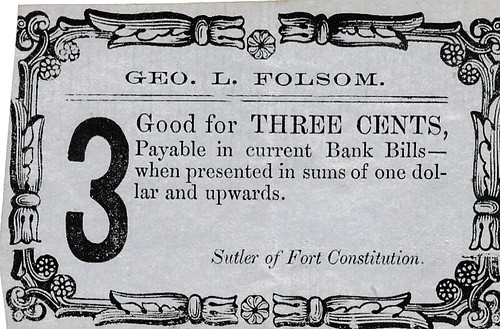
George L. Folson, Sutler of Fort Constitution (New Castle). 630-00.03-2
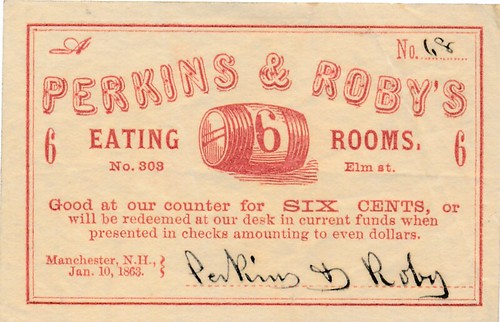
Perkins & Roby, Manchester. 1010-00.06-1
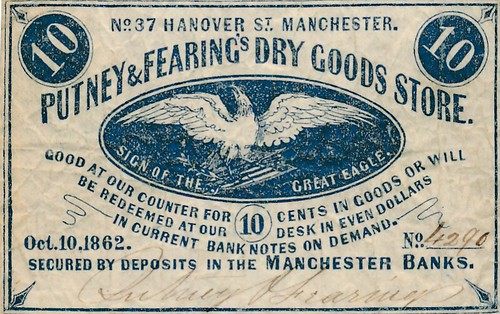
Putney & Fearing, Manchester. 1040-00.10-1
While most of these merchants' histories occupy no more than a page or two of text (excluding images), some—like those of John Davenport (Portsmouth) or Jones & Mendum (also Portsmouth)—are particularly substantial accounts. In most all cases, though, Lafond has managed to bring together period portraits and other photographs to serve as counterpoints to the lavish color images of the scrip notes themselves. Quite apart from its contents, this is a handsome volume whose quality of production would please the most ardent bibliophile.
At once a catalog of scrip and a compendium of commercial history at the most granular level, this volume hits a sweet spot between the schematic list making typical of catalogs and the rich details typical of local histories. As such, this valuable book should prove a resource to numismatists, professional historians, and general readers alike for a long time to come.
New Hampshire Merchant Scrip is available for purchase from the author, Kevin Lafond, P.O. Box 4724, Portsmouth, NH 03802-4724, for $89.50 plus $10.00 shipping (Make checks payable to Kevin Lafond). Inquiries to: kglafond@comcast.net .
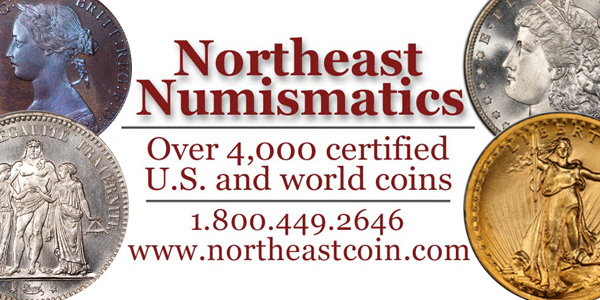
JOHN W. MCCLOSKEY, 1938-2018
We were sorry to learn this week of the passing of author and researcher John W. McCloskey of Dayton, OH. Thanks to Tom Mulvaney of Lexington, KY for passing this along. The March 2009 issue of the Gobrecht Journal included an autobiography of McCloskey (with edits by Len Augsburger and Bill Bugert). McCloskey was then the president of the Liberty Seated Collectors Club. The complete issue is available on the Newman Numismatic Portal and an excerpt is republished here with permission of LSCC. -Editor
 John William McCloskey was born on March 2, 1938 in Dayton, Ohio, the oldest of three sons, to John Henry McCloskey and Helen Rose (Kinzig) McCloskey. John's father
was the sixth of nine children in his family and was only thirteen when his father, John Thomas McCloskey, died in 1922. He appears in the 1930 census, as one of six children,
ages 1 4 through 27, living at home with their widowed mother. John Henry is listed as a "toolmaker" working at an electric refrigerator plant, and each of his five
siblings also held jobs to help support the family, all of which the census taker recorded. While single mothers had the worst lot of anyone during the depression, John
Henry's mother was surrounded by productive children. In 1935 John Henry and his bride rented a house at 209 South Findley Street in East Dayton while he was employed as a
tool maker, working for the ACME Pattern Tool Company. The economy relapsed in 1937 before gathering steam again during the war years. The family purchased a small home at 335
West Siebenthaler Avenue in North Dayton in 1940, and later moved to a larger residence at 132 Valley View Dr. in November 1945.
John William McCloskey was born on March 2, 1938 in Dayton, Ohio, the oldest of three sons, to John Henry McCloskey and Helen Rose (Kinzig) McCloskey. John's father
was the sixth of nine children in his family and was only thirteen when his father, John Thomas McCloskey, died in 1922. He appears in the 1930 census, as one of six children,
ages 1 4 through 27, living at home with their widowed mother. John Henry is listed as a "toolmaker" working at an electric refrigerator plant, and each of his five
siblings also held jobs to help support the family, all of which the census taker recorded. While single mothers had the worst lot of anyone during the depression, John
Henry's mother was surrounded by productive children. In 1935 John Henry and his bride rented a house at 209 South Findley Street in East Dayton while he was employed as a
tool maker, working for the ACME Pattern Tool Company. The economy relapsed in 1937 before gathering steam again during the war years. The family purchased a small home at 335
West Siebenthaler Avenue in North Dayton in 1940, and later moved to a larger residence at 132 Valley View Dr. in November 1945.
The family lived at the Valley View address for 33 years and it was here that young John spent his early years and developed a budding interest in coinage. He had a paper route at thirteen and spent his summers on a golf course as a caddy at Miami Valley Golf Club. This experience instilled in him a love for the outdoors and ended with him serving as a caddy for Ted Kroll during the PGA Championship when it was held at Miami Valley Golf Club during August 1957. Two years later, another young Ohioan, Jack Nicklaus, won the first of his U.S. Amateur titles, before taking the PGA himself in 1963. John was fascinated watching how the game was played at the highest level and this experience created his passion for golf that continues to this day. He has played well enough over the years to record five holes-in-one, four of them since the age of 60.
John attended Chaminade High School, a private school in Dayton, and graduated third in his class in June 1956. He then entered the University of Dayton and received a BS degree with a nnajor in Mathematics in June 1960. He married Norma Jean Monnin on August 6, 1960 and the young couple set out for Michigan State University where John had received a Graduate Assistantship in the Department of Statistics. He received his Masters Degree in 1962 and his PhD in 1965, both degrees in Statistics from Michigan State University. His PhD thesis involved a computer simulation of a statistical model at a time when computers were just beginning to be utilized in academic research.
Life as a University Professor
After considering several options John returned to his home town and accepted a position on the faculty of the University of Dayton as an Assistant Professor of Mathematics. While John was establishing himself in his academic career he and his wife Norma had four children, Susan Ann in 1963, John Thomas in 1965, Lisa Renee in 1966 and Mark William in 1972. As he advanced professionally John was appointed to a four year term as Chairman of the Mathematics Department at the University of Dayton on July 1 , 1976. Recognizing that he would be spending long hours performing his new academic duties, John felt he needed some extra time to prepare himself for the demands of his new responsibilities. He therefore signed up for a Sierra Club camping trip to the Uinta Mountains in Utah during June 1976 to think about his future in a peaceful and inspiring location. This was an important decision because the trip provided him with such a rewarding experience that he returned to the western mountains many times before the beginning of a new academic year.
John served twelve years as Chairman of the Mathematics Department, completing his third four year term on June 30, 1988. At this point he decided to test his skills in a physical challenge to celebrate completing his responsibilities as a departmental Chairman. He had always found inspiration on his trips to the mountains and decided to attempt a difficult physical challenge; he would try to climb a 14,000 foot peak. He studied his maps, read the climbing books and identified a peak in Colorado that he thought he could successfully climb. This turned out to be Redcloud Peak in Southwestern Colorado at 14,034 feet.
After several months of training he flew to Colorado during July 1988 and set up camp near the trailhead to Redcloud Peak. He had climbed in the mountains many times before but had never tried to climb one of the high peaks. But with a clearly defined goal and by refusing to be denied when challenged, he reached the peak after a long five hour climb and was over-joyed by his success and the beautiful landscape that surrounded him. It was such an exhilarating experience that he knew he would have to try it again!
... This success led to many other trips to the western mountains over the next twenty years where he has successfully climbed 31 peaks over 14,000 feet, all of them since the age of 50.
In the fall of 1988 John returned to his position as Full Professor in the Mathematics Department at the University of Dayton and resumed his teaching and research duties. His professional work involved mathematical modeling where a mathematical structure is imposed upon a physical phenomenon to obtain information that would not be apparent by simply observing data. John served an additional thirteen years on the faculty at the University of Dayton before retiring in June 2001 after 36 years of service.
Early Collecting Interests
John's collecting interests began in 1948 at the age of ten with a jar of old Lincoln cents that his father kept in a desk drawer in the den. He would dump the coins out on a table and line them up by date to see how many he could find. As his father added coins to the jar he would try to fill the holes in the date sequence for the series. Before long his father bought him a coin folder for Lincoln cents and he began searching through change to fill in the missing dates. Thousands of children John's age were doing precisely the same thing, as a rising coin boom which continued unabated through the mid-1960s began to take shape. The Redbook first appeared in 1946, while periodicals such as the Numismatic Scrapbook Magazine became thicker every month. By the late 1950s the need for a weekly coin magazine was evident, and Coin World was launched in 1960. Much of the commercial activity was focused on modern issues, BU rolls of recent vintage or supposedly rare items like 1950-D Jefferson nickels. John took a different path, and early on developed a taste for the older, more esoteric issues.
At 13 John would take a trolley bus to downtown Dayton and purchase nice circulated Lincoln cents, Buffalo nickels and Mercury dimes. At 15 he would ride twenty miles on his bicycle with a friend to visit Whitt's Hobby Shop in Franklin, Ohio. While there he would purchase Barber dimes for 35 cents. Barber quarters for 65 cents and Barber half dollars for $1.25. He began collecting Seated dimes in 1955 because they represented the next oldest dime series and many of them could be purchased at reasonable prices in nice circulated grades. In doing so, John landed in virgin territory. The first American collectors tended to focus on Colonial and early copper issues; later, in the first half of the twentieth century, the second wave of collectors began pursuing early silver varieties with the three Bs - Browning, Beistle and Bolender who had taken the lead in cataloguing Bust coinage. Seated coinage remained largely unexplored.
Seated Dime Research
While initially collecting Seated coinage John was attracted to the sharp lines and fine detail in the design that was lacking on many of the 20th century coins. But collecting this series soon presented some concerns because some of the dates were very rare and nobody seemed to know how to authenticate individual specimens. One particular incident with a rare date made a lasting impression on him. In 1964 he visited a coin shop in Lincoln, Nebraska and was shown a nice original 1866 dime in a VG grade. This was a very rare date with a low mintage and he had never even seen one before. The purchase price was $12 and he was thrilled to have the opportunity to buy an example of this rare Civil War issue. But upon returning home he compared this coin with the 1866-S dime in his collection and found that he could not find any distinguishing features between the two pieces. The mintmark on his 1866-S dime was very weak and he feared that the San Francisco mintmark might have been completely worn off the VG coin that he had just purchased as an 1866 dime. Only several years later did he learn of the differences in date position between 1866 and 1866-S dimes that could confirm the mint of origin for coins of this date.
The bulk of the lengthy article details McCloskey's research into Liberty Seated dimes and quarters, Bust dimes and half dimes, and classic and branch mint gold.
Research Activities as LSCC President
John began his term as President of LSCC in September 1975 and has published three issues of the Gobrecht Journal each year for the past 34 years. His numismatic skills were demonstrated very early when he published an article in Issue #2 describing the new Type II reverse first used on Seated dimes in 1876. This article included a list of the dates for which both Type I and Type II coins were known. In Issue #3 he published an article that listed the reeding count for all dates in the Seated dime series. He then showed that the rare Carson City and New Orleans dates could be authenticated by the number of reeds along their edge. In Issue #5 he published articles on the 1841-0 Transitional dimes, the three mintmark sizes for 1862-S half dollars and reeding counts for Seated half dimes. In Issue #6 he described die characteristics that distinguish 1866 and 1866-S dimes, described and illustrated a new reverse hub for quarters in 1861 and described the 1840-O Transitional half dime. He continued to show his extensive knowledge of Seated coinage over the years by publishing a steady stream of ground breaking articles on all Seated denominations from half dimes to Trade Dollars.
One of the most important decisions that John made in the early years was to publish collective volumes of the material that had appeared in earlier issues of the journal. During the late 1970s new club members would request copies of back issues from previous years. After the club ran out of back issues there were discussions on how to meet a growing demand for this material. The simplest approach would have been to reprint extra copies of the earlier issues as they were originally printed. However, John felt that this was not the best approach because the ads were no longer current and specific articles would be difficult to find in individual booklets. He felt that a better way to preserve the material published by the club would be to reprint the articles that had been published over a five year span in a single collective volume. He then decided to reorder the articles by denomination and date so that all of the material on a particular topic would appear together in the new volume. This required a massive restructuring of the published material but a 367 page manuscript eventually emerged containing the articles in the first 18 issues of the journal. This manuscript was published in 1981 and became Collective Volume Number One. It was so successful that three more collective volumes were published, each containing the restructured articles over a five year span. A new Collective Volume Number Five covering the years from 1995 to 2000 is about ready for publication.
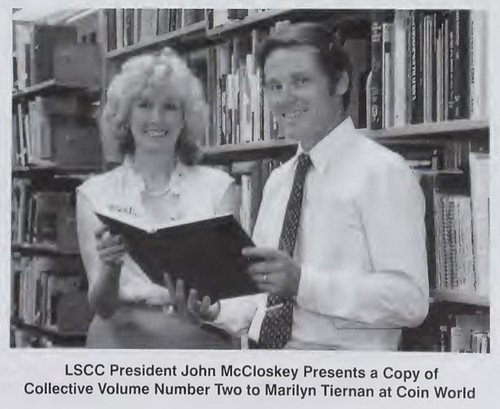
In recent years John has used his knowledge of gold coinage to prepare a number of articles that run across all denominations from copper half cents to gold double eagles. In Issue #74 he described and illustrated five date punches of varying size for the year 1842 that were used to prepare the dates on 10 denominations of coinage from copper half cents to gold eagles. His analysis showed that the Small Date and Large Date varieties for Seated quarters and half dollars were the result of nothing more than a switch from one available date punch to another while preparing the coinage dies. In Issue #100 he described the seven date punches of varying size for the year 1856 that were used to prepare the dates on 13 denominations of coinage from copper half cents to gold double eagles, only this time there was an interesting pattern of slanted and upright 5s used on the date punches. In Issue #84 he illustrated three mintmark sizes that were used on San Francisco dies for 10 denominations of coinage from the dime to the gold double eagle during the No Motto era from 1854 to 1866. This analysis showed that the same mintmark punch was used on many different denominations of coinage during these years.
From Seated to Bust coinage, and later to gold, John has exhibited an insatiable curiosity coupled with careful and systematic analyses in order to produce standard works which will endure for the foreseeable future. The respect he has won from his peers is considerable, yet easily forgotten. Giants like Harry Bass, who knew gold varieties as well as anyone, are no longer on the scene to attest to John's acumen. Likewise, Kam Ahwash, who passed away so prematurely, surely had stories relating to how he and John pushed each other to continually dig deeper into the production of Seated coinage. As is demonstrated by John's Bust dime and half dime books, truly outstanding numismatic research is often a group effort, achieved by a number of high-performing individuals who are willing to collaborate as a team, share findings, and consistently challenge both old and new findings. John has exercised this ability within LSCC as well, and today serves as a sounding board and voice of reason to all those interested in researching Gobrecht's silver coinage from the 19th century. We are quite blessed with his presence, and hope that he continues to scale his mountains, numismatic and otherise, well into the future.
To read the complete article, see:
https://nnp.wustl.edu/library/book/179?page=4
W. David Perkins of Centennial, CO writes:
I first met John McCloskey (in person) at the 1985 Central States Numismatic Society (CSNS) show in Minneapolis in 1985. This was my first larger coin show, having “gotten back” into collecting in 1983. I was a member of the Liberty Seated Collectors Club (LSCC) which John McCloskey had co-founded along with Kamal Awash. John was the long time President and Editor of the club's Gobrecht Journal. By long time I mean around four decades! John was also a founding member of the John Reich Collectors Society (JRCS) and a long-time Vice President of this club. I've been a member of both clubs for over 30 years now.
I wrote a letter to John prior to the 1985 CSNS Convention offering to pick him up at the airport and drop him off at his hotel if he would come to my house and look at my collection and give me feedback. I'd been collecting for two years or so and wanted feedback on the coins I'd purchased so far for my collection. Much to my surprise and pleasure John agreed to do this.
I picked John up and we drove to my house. I had my Seated Dollar collection home from the bank, mostly consisting of XF-AU coins. At one point John asked me if I used a glass when looking at my coins. I remember saying that I did not, should I? He said yes, but he added that he hadn't noted any mistakes on the coins he had seen so far. I guess that I had “young eyes” at the time with very good eyesight up close. Or was lucky. At the end, John asked me which coin did I think was his favorite. It turned out it was an 1864 Dollar in VG-Fine, a well circulated Civil War Date.
At the show, John took me around and introduced me to a number of collectors. I remembering John introducing me among others to Mr. 1873, Harry X Boosel and to Russ Logan, an author and later founder of JRCS. Over the years I saw and talked with John at the major shows.
John was a co-author of Early United States Dimes 1796 – 1837 (1984, John Reich Collectors Society) with David J. Davis, Russell J. Logan, Allen F. Lovejoy, and William L. Subjack. John was also a co-author of Federal Half Dimes 1792-1837 (1998, John Reich Collectors Society) with Russel J. Logan. This is still a widely used reference for those collecting the early half dimes 1792-1837. John wrote untold articles on early silver and gold for the John Reich Journal and for the Gobrecht Journal.
The hobby will miss John.
Dave provided the following links for more information. -Editor
THE PROFESSOR'S PASSION – John McCloskey takes Seated
Liberty coinage seriously (https://coinweek.com/coin-clubs/the-professors-passion-john-mccloskey-takes-seated-liberty-coinage-seriously/)
A History of the JOHN REICH COLLECTORS SOCIETY (http://jrcs.org/aboutjrcs_history.php)
Len Augsburger writes:
John McCloskey literally was the Liberty Seated Collectors Club (LSCC) for nearly 40 years. He served as president, edited the Gobrecht Journal, and personally supplied a good fraction of the content of that publication. McCloskey went an inch wide and a mile deep – so much so that he was not so well-known outside of the LSCC and the John Reich Collectors Society (JRCS). Indeed, when ANA Governor Michael Fey nominated McCloskey for a well-deserved ANA award, it was only then discovered that McCloskey was not an ANA member and unfortunately not eligible. McCloskey had been receiving the LSCC club copy of The Numismatist for years and never bothered to personally subscribe!
The real legacy of John, however, is the rigor with which he approached die variety attribution of the 19th century U.S. silver and gold coinage. John co-authored the standard references for bust dime and half dime varieties, and this tradition lives on through the work of numismatic authors such as Gerry Fortin, Bill Bugert, and others, whose collecting careers and research instincts were influenced by John.
McCloskey was also an expert on Classic Head U.S. gold, but unfortunately did not live to see his work in this area published. Fortunately his manuscript has been shared other experts, and it is hoped that this research will someday be widely available. I last saw John at the LSCC general meeting at the 2018 Philadelphia ANA, and am grateful that his wife, Norma, was able to bring him to this event.
Dave Lange writes:
It seems like 2018 was a particularly sad year for numismatics, with the passing of so many great figures. The latest loss is John McCloskey, and he was indeed a key player in the study of United States silver and gold coinage of the 19th Century. Though he was not the first editor of The Gobrecht Journal, he held this position for so many years that it is indelibly associated with his name. He also served as the Liberty Seated Collectors Club president for decades, and its survival for over 40 years is due mostly to his dedication and persistence. My mother told me that when FDR died she couldn't believe that anyone else could ever be president of the USA, and this is how so many felt about John and the club.
John was very instrumental in helping me to achieve success as a numismatic writer, and I became a prolific contributor to TGJ during the 1980s. I searched for an actual photo of the two of us together, but other than group shots all I could find is the attached news clipping from a 1983 issue of Coin World. It shows us during the LSCC annual meeting at that year's ANA Convention in San Diego. I'll always remember him as a friend and as a figure in the hobby who was all too modest for someone of his many accomplishments.

Thanks everyone. -Editor
To read Mccloskey's online obituary in the Dayton Daily News, see:
McCLOSKEY, John
(https://www.daytondailynews.com/classifieds/obituaries-announcements/mccloskey-john/L1YCljNiLfgvk6taB8Y6YI/)

NUMISMATIC TIMEPIECES ON THE NEWMAN PORTAL
Newman Numismatic Portal Project Coordinator Len Augsburger provided the following timely report for the New Year. Thanks! -Editor
The new year reminds us of time marching ever forward, but, if one can find a numismatic connection, the loss of time will perhaps be felt less intensely. To the rescue comes the Eclectic Numismatic Treasure collection of numismatic timepieces, currently featured in a Newman Portal image gallery.
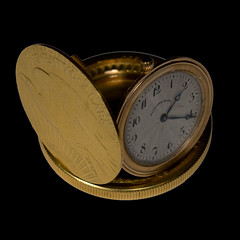 Coins make natural faces for watches or watch cases, and the most spectacular item in this collection is a Tiffany “pop-up” watch featuring a 1909 Saint-Gaudens double
eagle. On this piece, the reverse of the coin and the watch dial literally pop-out of the enclosure and can be neatly tucked back into the shell built around the obverse of the
coin. Housed in the original Tiffany box, the expert workmanship of this piece represents an elegant way for a numismatist to keep track of time.
Coins make natural faces for watches or watch cases, and the most spectacular item in this collection is a Tiffany “pop-up” watch featuring a 1909 Saint-Gaudens double
eagle. On this piece, the reverse of the coin and the watch dial literally pop-out of the enclosure and can be neatly tucked back into the shell built around the obverse of the
coin. Housed in the original Tiffany box, the expert workmanship of this piece represents an elegant way for a numismatist to keep track of time.
It also represents a dilemma – use of the object will cause wear on the coin, but keeping the object stored away robs the user of its utility. In this case, the user clearly opted for utility as the wear on the $20 gold piece demonstrates many hours of useful service.
Link to Eclectic Numismatic Treasure timepieces on Newman Portal:
https://nnp.wustl.edu/Library/ImageCollection/511224
QUERY: BOOSEL'S 2 1/2 CENT COIN CONCEPT
Len Augsburger of the Newman Numismatic Portal has a question for E-Sylum readers. -Editor
THE U.S. NEEDS A 2½ CENT COIN
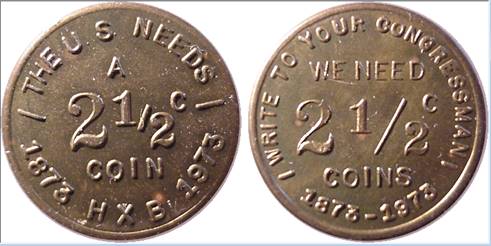
An NNP reader this week asked about a promotional token created by Harry X Boosel in 1973, lobbying for a 2½ cent coin. The token claims “we need 2½ cent coins” and that fellow lobbyists ought to “write to your congressman.” Surely there is more to the story – why was Boosel convinced of the utility of such a denomination, and did the effort ever gain any traction? Nothing was immediately found on the Newman Portal, although there is a single use of the initials “HXB” in the Chicago Coin Club Chatter, in reference to Boosel. The token itself is listed on tokencatalog.com as TC-378397. Can E-Sylum readers help solve the mystery?
Link to Boosel token on tokencatalog.com:
http://tokencatalog.com/token_record_forms.php?
action=DisplayTokenRecord&td_id=378397&inventory_id=
371441&td_image_id=211023&attribution_id=387648
&record_offset=0
I'd never seen or heard of this token or concept before. I didn't know Boosel, but had the pleasure of meeting him briefly at an ANA convention. Can anyone help? -Editor

THE WESTERNER NEWSLETTER
David Lange submitted these notes on an interesting and little-known numismatic publication. Thanks! -Editor
A recent purchase on eBay of several items in a single lot included the attached issue of The Westerner, an employee newsletter put out by Western Publishing Company, Inc. That was the parent company of which Whitman Coin Products was a division. This copy is Volume 1, Issue 4, April 1995, and since acquiring it I've been seeking additional issues without success. A search on "The Westerner" produces mostly cowboy hats, motels and comic books.
It was in 1995 that Western vacated its landmark Racine, Wisconsin building, letting go many employees in the process. Whitman albums and folders were thereafter published under the Golden Books name for about three years, and indeed the longest article in this issue pertains to growing the Golden Books brand. The front cover shares this study with a piece about when Western received the ANA's Medal of Merit award in 1990 and then, more recently, its Presidential Award. Both the company and longtime employee Ed Metzger were given this award, and Ed's smiling face is seen on the front cover. A sidebar story features Richard S. Yeo and recounts his accomplishments with the company years earlier. Aside from this there's no numismatic content, though I did spot Kurt Krueger within a group photo of the Diversified Deviations Team!
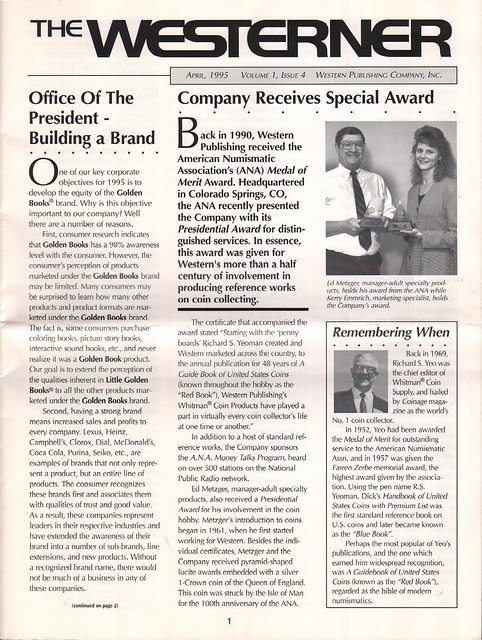
It's the charm and strength of an auction platform like eBay that one can find the most obscure items at almost any time. And them you can search for a decade and not find another. But never give up the hunt - you never know what treasure someone will post tomorrow. -Editor
AN ANALYSIS OF ISIS COIN PRODUCTION
Olivier Moos writes:
I'm a Swiss historian and I recently published an essay online about the Islamic State coinage production in Syria and Iraq. Given the subject, I thought your readers might be interested. The E-Sylum proved indeed very helpful to support some of my hypotheses.
I'm glad to hear our earlier articles were useful. Olivier's analysis is very thorough, and compares the announced candidate designs with the coins actually produced. Here's a lengthy excerpt, but be sure to read the complete analysis online - it's the best report I've seen yet on this series which is so enigmatic to those of us in the West. -Editor
Although a theoretically ever-expanding Caliphate does not recognize international borders or traditional states, its leadership nonetheless strived to reproduce all the traditional signs of sovereignty. Last but not least, they created a new currency. Minting of dinars and dirhams was the final component in solidifying the physical reality of the group's millenarian utopia.
In November 2014, issue 5 of the Islamic State English-speaking magazine Dabiq (p. 19) unveiled a new currency to be soon minted and put into circulation: a series of seven coins divided between two gold dinars, three silver dirhams and two copper fulûs (sing. fils or fals).
This new ISIS currency was meant to replace the paper money of Syrian Pound, Iraqi Dinar and US dollar, the three most commonly used currencies in the area then controlled by the Islamic State.
Predictably, the group's new financial policy was both brief and chaotic. However, it did serve what was one of its main purposes, adding a further layer of legitimacy and authenticity to the Caliphate-building endeavour. This was a rather revolutionary strategy within a Salafi-Jihadi ecosystem articulated on small insurgency groups and clandestine networks. The gold dinar and silver dirham came to gild the false ceiling of a utopian State already overloaded with kitsch paraphernalia exalting the return of the King and cavalry charge, jihadi-warrior lyrics, baroque prophecies and apocalyptic battles.

Dinar and dirham, Omayyad period, between 7th and 8th century
The coinage put into circulation were partially inspired by 7th century Omayyad models. They went through different stages of development but usually bore the profession of faith (shahâda) surrounded by references to the prophetic mission of Mohammad, an extract of the Qur'an, and the minting date. Borrowing characteristics from the first Islamic coins produced by Abd al-Malik Ibn Marwan's (646-705) caliphate was an attempt to recapture some of the prestige of the first Arab dynasty that had made Damascus the heart of an Empire.
The rejection of banknotes signalled a decisive exit from the international financial system...
Gold Dinars
The first prototype initially presented in 2014 by the Islamic State was made of 4.25 gr. of gold and estimated to be worth about 140 USD. Below, an image of the prototype and a
photograph of a coin put into circulation by the organisation between 2015 and 2016:

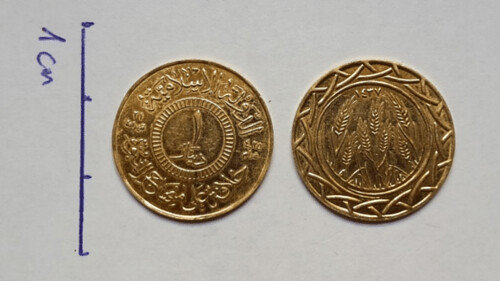
The engraving on the reverse is the wheat sheaf of 7 ears and represents the “blessings of sadaqah (voluntary charity)” (Dabiq 5). It refers to a Qur'anic verse: “The example of those who spend their wealth in the way of Allah is like a seed [of grain] which grows seven spikes; in each spike is a hundred grains. And Allah multiplies [His reward] for whom He wills.”
The main symbol remains the same on the 2014 prototype but with a large groove added on the edge. The year is 1437 of the Hegira (i.e. between October 15, 2015, and October 2, 2016). The general aesthetic of the obverse is different but provides the same information: a circular legend identifies (on top) the Islamic State (ad-dawla al-islâmiyya) as the issuing authority, and states (bottom) “a Caliphate according to the model/method of the prophecy” (khalifaton ‘ala Minhaji Al-Nubuwwah). The same legend is found on all the coins.
The central circle contains the denomination numerals 1 Dinar flanked on each side by indication of weight (4.25 gr.) and carats (21). Those numbers are equivalent to the weight, purity (87.5%) and size (2 cm) of the first Islamic dinars produced at the end of the 7th century.
It is interesting to note that, in 2015, while the Islamic State was still announcing a dinar of 21 carats, the spectrometric analysis of the 1 gold dinar specimen pictured above reveals a higher purity: an alloy composed of 91.58% of gold and 8.42% of copper, i.e. 22 carats.
Why a higher purity? Our hypothesis, further developed in the third chapter, is that the Islamic State produced a first and quantitatively modest cycle of minting, circa June-October 2015, including an unknown number of 21 carats dinars. There is circumstantial evidence that this first cycle of production included, or was put into circulation at the same time as, a number of gold-plated dinars of substantially lower quality. This predictably tarnished the reputation of the new currency and triggered a second cycle of minting.
The initial choice of 21 carats was probably not inspired by the standard of Omayyad coinage, but was due to its common usage in the Arab world. Nostalgia has its limits, as the modern and clean aesthetic of the emblematic 5 gold dinar illustrates. Indeed, nothing “traditional” to it.
I was interested to see this confirmation of the existence of the gold coin. The silver and copper coins are photographed and analyzed as well - their match the ones i acquired for my collection and illustrated in the earlier articles. Also of interest for numismatists is a discussion of the minting process. -Editor
According to interviews collected by Religioscope, the Islamic State had established several minting workshops. We know from the Turkish press that in 2015 a clandestine workshop was set up in Sahinbey, halfway between Gaziantep and the Syrian border. We also have evidence indicating that a striking factory was established in 2015 in Mosul, Iraq, and later was moved or replaced, possibly in Mayadin, Syria.
In March 2018, Al-Alam, an Arabic language outlet based in Iran, published a few pictures of what is described as ISIS minting equipment in Hasrat, a small village near Abu Kamal in the south east corner of Syria, recently recaptured by the Syrian armed forces:
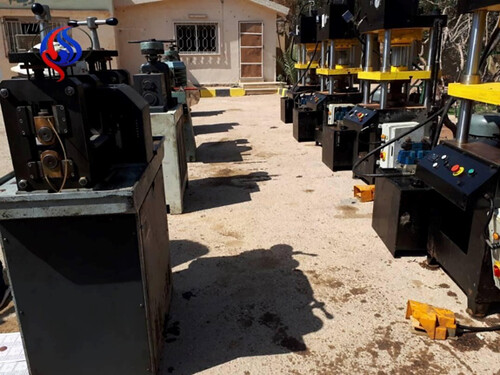
The authenticity of these specimens is solid, a robust body of evidence indicates that they were produced and distributed by the Islamic States in Syria and/or Iraq as of 2016. We compared several collections of coins (i.e. four sets of six coins ranging from 1 gold dinar to 5 fils, unfortunately none including the 5 gold dinar) and all collections were identical in size, weight and design and were provided by different sources based in Syria. It is worth noting, however, that only the set illustrated in this article went through a spectrometric analysis.
The Syrian sources from Raqqa with whom Religioscope conducted interviews in the spring of 2018 explained that a substantial number of their countrymen had hoarded dinars and dirhams before quickly selling or melting them as soon as the followers of the Caliph had retreated. It is likely they also melted these down to avoid being accused as sympathizers or members of the Islamic State by the new occupying forces.
See the end of the article for the conclusions of the analysis. This is by far the best discussion I've seen to date. Thank you for sharing this with us! It's a fascinating contemporary topic; these early reports and studies will provide a basis for all subsequent cataloging of the pieces in the numismatic literature. -Editor
To read the complete article, see:
The Return of the Gold Dinar – An analysis of the
Islamic State coin production (https://english.religion.info/2018/12/23/the-return-of-the-gold-dinar-an-analysis-of-the-islamic-state-coin-production/
To read the referenced E-Sylum articles (each of these has links to still more), see:
ISIS MINT FOUND IN TURKEY (https://www.coinbooks.org/esylum_v18n41a21.html)
NEW IMAGES OF ISIS COINAGE (https://www.coinbooks.org/v21/esylum_v21n05a24.html)

NOTES FROM E-SYLUM READERS: DECEMBER 30, 2018
On Bimetallic Tokens
John Mutch writes:
I have to take exception to the statement in the Vocabulary Term: Bimetallic article in the sub-heading Bimetallic Tokens. The usual scenario is an aluminum center with a brass outer ring, not the other way around. The arrangement as stated is true for encased cents, etc. but not for tokens. And, the Schenkman book is a true book, not a list. Dave states that there are "numerous exceptions" to the convention of having a harder metal for the outer ring (to reduce wear), but posits that they were made in an effort to circumvent the George G. Greenburg patent of 1899.
Thank you. Patents and patent avoidance make for some otherwise hard-to-understand choices. Interesting possibility. -Editor
To read the earlier E-Sylum article, see:
VOCABULARY TERM: BIMETALLIC (https://www.coinbooks.org/v21/esylum_v21n51a12.html)
More on Valentine Varnishes Tokens
Dave Schenkman writes:
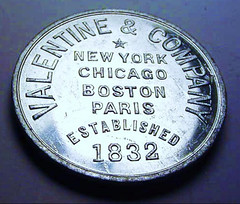 The 1882 Valentine Varnishes token pictured in The E-Sylum is very common. Far rarer are the numerous other tokens issued by the company, some of which use the
intermingled letters in the name. In Merchant Tokens of Hard Rubber and Similar Compositions I list thirteen different types, some of which exist in more than one color of
rubber. In fact, they issued a token identical to the one you pictured in five different colors of rubber.
The 1882 Valentine Varnishes token pictured in The E-Sylum is very common. Far rarer are the numerous other tokens issued by the company, some of which use the
intermingled letters in the name. In Merchant Tokens of Hard Rubber and Similar Compositions I list thirteen different types, some of which exist in more than one color of
rubber. In fact, they issued a token identical to the one you pictured in five different colors of rubber.
Thanks. That would make for an interesting collection. -Editor
To read the earlier E-Sylum article, see:
NUMISMATIC NUGGETS: DECEMBER 23, 2018 : Valentines Varnishes Medal
(https://www.coinbooks.org/v21/esylum_v21n51a19.html)
Query: A Clad Dime Minus Its Cladding?
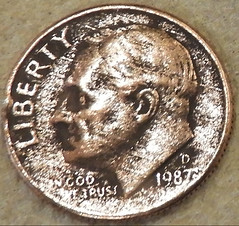

Nick Graver writes:
Here are pictures of a 1987-D dime that appears to be struck on an 'un-clad' planchet, lacking the top and bottom of the usual sandwich. The piece is very rough and porous and much lighter than usual. Puzzling are a number of horizontal 'ridge' raised lines that may have been caused by scratches into the obverse striking die.
Bruce Tyo of Rochester, NY found it and offers it for your readers' pleasure. Frank Calandra of Webster, NY deserves photo credit for the images.
What is misleading is the pictures show the coin as a silvery color, but it is actually a coppery warm tone.
This is not an area I'm familiar with, but if the coin is copper colored and much lighter than normal that's consistent with the theory that the coin is lacking its outer layers. What do readers think? -Editor
Query: Columbia & Washington Medal Ship
Gene Anderson writes:
In researching the Columbia & Washington medal, I find there are conflicting statements as to the place and time of the Columbia's construction. Various sources, including the Ford V catalog, give the location and date as 1773 in Marshfield, Massachusetts. Frederic Howay cites two registers of the Columbia found in the National Archives that indicate the ship was constructed in Plymouth, Massachusetts in 1787. Can anyone shed any light on these conflicting sources? Could these be different ships with the same name?
Good question. Can anyone help? -Editor
Trump Slogan Stamped on $20 Bill
We've often discussed circulating banknotes with political slogans on them, such as the following, submitted by Gary Beals. A reader had mentioned the existence of these stamps, but this is the first image we've had of a stamped note. -Editor

To read the earlier E-Sylum articles, see:
TRUMP SLOGAN ON $20 BILLS (https://www.coinbooks.org/v21/esylum_v21n20a35.html)
MORE ON POLITICAL SLOGANS ON BANKNOTES (https://www.coinbooks.org/v21/esylum_v21n21a16.html)

MORE ON THE KP CHRISTMAS SILVER ROUNDS
Regarding the Krause Publications Christmas ornament, George Cuhaj writes: 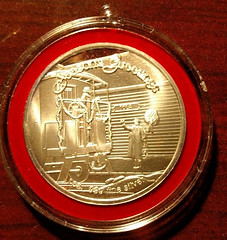
The Christmas Silver round was a KP thing for several years when the company was still employee-owned. They were made by Silvertowne from reclaimed silver from the film negative developers. Many of the KP rounds during those days were from such reclaimed silver.
This particular one shows Colin Bruce on the caboose, and George Cuhaj on the station platform. The caboose and station form a centerpiece of the Iola Historical Society's building collection. It was matched with a color printed card as a night scene.
How magic - who else can claim to be on a Christmas ornament, looking out at the holiday festivities? There may be a Disney/Hallmark Channel movie script in here... Thanks for the background. Collect 'em all, everyone. -Editor
George adds:
I have not done a Standard Catalog of Krause Publications Silver Ounce Ingots/Rounds, but a full set is probably over 50 pieces, some of which are fairly uncommon (and some types were even struck in .999 gold).
Many employees were not numismatically inclined, and many have gone into the big melt pot when silver was at a more advantageous number.
George followed up with the following photos and text. Thanks! First is the Krause Christmas card that used the image. -Editor
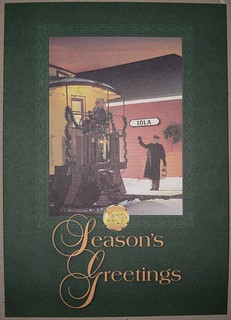
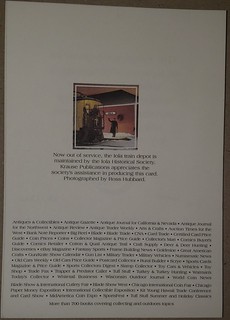
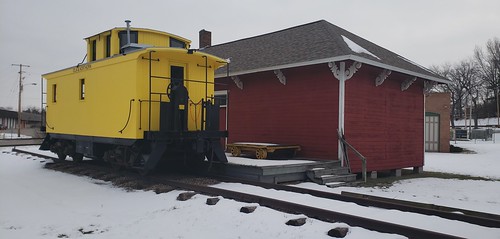
Here is a view of the Iola Station and caboose. The Caboose was moved a bit since the KP image was taken. The station sign was added in the card image and the round by the graphics department. This past summer a multi-year exterior renovation was completed, which resided the caboose to a bead board finish. The station is in its original location as built in 1894.

In the second image, the re-built bay window on the station is visible, and in the background is a reconstruction of our first fire house, expanded to three bays from the original two (as the collection includes two trucks and a horse drawn vehicle).
To read the earlier E-Sylum article, see:
WAYNE'S NUMISMATIC DIARY: DECEMBER 23, 2018 (https://www.coinbooks.org/v21/esylum_v21n51a23.html)
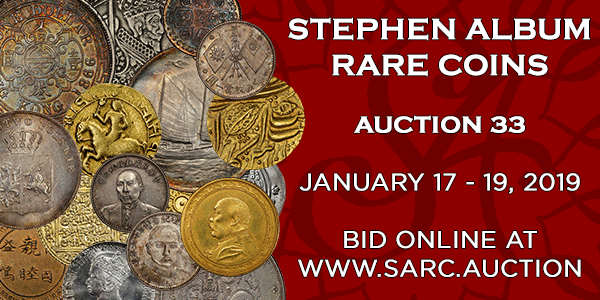
THE "WE ALL HAVE OUR HOBBIES" TOKENS
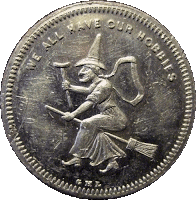
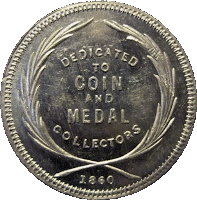
NY 491A, white metal, 27.3mm
Dave Baldwin writes:
I thought your readers might be interested in the new page on my website for the "We All Have Our Hobbies" tokens by George H. Lovett. They always seem to be pretty popular when they come up for sale these days.
Thanks. A popular piece. Strange, but that only helps its allure. Here are some additional selected images - see the complete page for more. -Editor
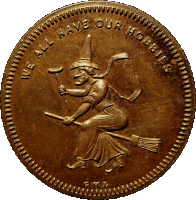
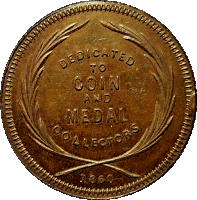
NY 491C, copper, 28mm

Luther B. Tuthill advertisement in The Numismatist, Vol. VII, No. 1, January (1894)
The obverse design and motto is not an original design by George H. The witch on a broomstick with similar mottos were found on seal fobs in England at least by the early 1800's. These would have been worn on a watch fob, or possibly a necklace in the case of a woman, and used to stamp wax to seal a letter.
So how did the expression "We all have our hobbies" come to be associated with the image of the witch on a broom stick? "To ride one's hobby-horse" meant to follow a favorite pastime and eventually led to our modern usage of the word hobby. And the image of the witch on her broom stick is very much like a child riding their stick or hobby horse - so she is pursuing her 'hobby'.
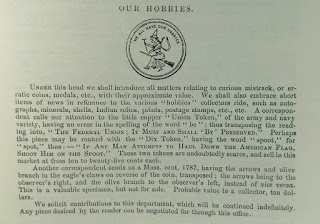
From Mason's Monthly Illustrated Coin Collector's Magazine, and Price Current, Vol. 1, No. 1, June (1884) : 13.
To read the complete article, see:
George H Lovett Gallery Part 3 : "We All Have Our Hobbies" Token
(http://ghlovett3.blogspot.com/p/historical-discovery-of-ameica.html)
THE "SMOKING OF THE WEED" TOKEN
Speaking of unusual tokens, here are a couple produced by J. N. T. Levick for his Woodgate business, courtesy of Dave Bowers. -Editor
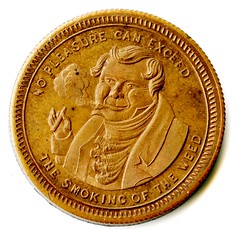

That "Smoking of the Weed" token could raise eyebrows today. The other piece has a more traditional obverse with George Washington. -Editor
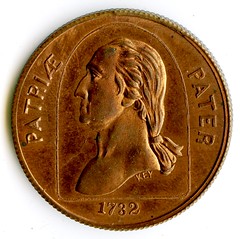
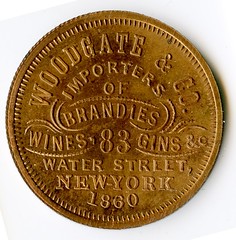
A web search for more information on the "weed" token led me to a numismatic article I wasn't aware of - it's by Dr. Horatio R. Storer, titled The Medals, Jetons, and Tokens Illustrative of Sanitation, published in multiple parts in The Sanitarian. -Editor
I have already intimated that not merely undue indulgence in drink but the excessive use of narcotics has been attempted to be checked through the means of medals. Indeed these have been made incentives as well as preventives in both cases. In the former the tokens and advertising cards of inns and saloons and even beer and whiskey checks form a special department of numismatics however uninteresting it may seem. And so there can be no doubt that a taste for cigarettes and the pipe has been encouraged by the craze that exists among boys at the present moment for collecting what are called tobacco "tags". As an instance of similar direct encouragement may be cited the following:
395 Obverse Bust of a plethoric old fellow with cigar in hand half facing to left and blowing a cloud of smoke. Legend : No Pleasure Can Exceed | The Smoking of The Weed. Reverse. Within a wreath of leaves a cigar box upon the side of which a crown surmounting the word Regalias. Above, two crossed pipes. Inscr,: Levick 904 Broadway | New York Exergue: 1860 Edges milled. White metal 18
This is in my collection.
The reverse described is different from the one pictured above, but this confirms that the subject is the smoking of tobacco, and introduced me to the term "tobacco tags" for the tokens of tobacco sellers. Interesting sideline. -Editor
To read the complete article, see:
The Sanitarian, Volume 20 (https://books.google.com/books?id=RTegAAAAMAAJ&pg=PA354&lpg=PA354&dq=no+pleasure+can+exceed+the
+smoking+of+the+weed&source=bl&ots=8NxtXKvFU_&sig=plLt-
YA1GpFdqkZSqgfPSIQBvCE&hl=en&sa=X&ved=
2ahUKEwjKhY
S7qbnfAhUqUt8KHZJeC_cQ6AEwCnoECAQQAQ#v=onepage&q=no
%20pleasure%20can%20exceed%20the%20
smoking%20of
%20the%20weed&f=false)
Another web page has an image of the "crossed pipes" version, with text largely cribbed from 100 Greatest American Medals and Tokens. -Editor

The obverse shows a well dressed, happy gentleman smoker half facing left holding a cigar and exhaling a cloud of smoke. At the border is the inscription NO PLEASURE CAN EXCEED / THE SMOKING OF THE WEED. (In 1860, “weed” meant tobacco with no other connotation.) The reverse shows crossed pipes above a tobacco or cigar box with the text REGALIAS surmounted by a crown. Above the pipes is the inscription LEVICK 904 BROADWAY NEW YORK in two lines with the date below. The whole is surrounded by a closed wreath of tobacco leaves. There are dentils on both sides of the token. It was struck in silver (the present piece), brass, copper, and white metal.
Joseph N.T. Levick commissioned George Lovett to design a large group of tokens not only for his tobacco business, but also for his personal collection. Levick was a lifelong smoker who lived to the age of 80. There are many mulings of this famous obverse and reverse with other dies to create rarities for the avid collector, but the above piece is the original advertising card and probably the first group made for Levick by Lovett.
To read the complete article, see:
1860 Levick Smoker
Token No Pleasure Can Exceed the Smoking of the Weed
(usrarecoininvestments.com/coins_for_sale/1860-levick-smoker-token-no-pleasure-can-exceed-the-smoking-of-the-weed-ngc-unc-details-7791006_5725_d.htm)
And of course, Dave Baldwin has a page devoted to the varieties on his web site. -Editor
To read the complete article, see:
Merchant Tokens of J.N.T. Levick & Woodgate & CO.
(http://ghlovett.blogspot.com/p/merchant-tokens-of-jnt-levick-and.html)
THE BOOK BAZARRE
VOCABULARY TERMS: CONTEMPORARY
Dick Johnson submitted these entries from his Encyclopedia of Coin and Medal Terminology. Thanks. -Editor
Contemporary. Occurring during the same period; said of a medallic or numismatic item made during the lifetime of its artist, or within a brief period of time after its original issue. The use of the term implies some form of copy or replica; thus it is in contrast to original and often employed with after-cast. It is important to know if a copy was made close to the time of its original issue – contemporary – or at a later time.
A contemporary copy of a renaissance medal is quite desirable. Any after-cast made at a later time with less sharpness of detail and smaller diameter (shrinkage) is, of course, less desirable. Thus a piece made by the artist, or during his lifetime may have been under his control with all the detail and finish the artist intended.
A contemporary copy of a current medal is a gray area. Should the original medal be protected in some way – as copyright, bearing a trademark, or perhaps, licensed – it may prove illegal to reproduce and sell for profit. The status of any other copies are determined by the intent of the person reproducing it.
A contemporary copy of a coin is a forgery – illegal at the time of its creation and will always remain so. Should such a forgery survive to the present and the issuing country is no longer in existence or the piece has been demonitized, it is a numismatic artifact worthy of study. Forgeries of the current coin of any existing country are, of course, illegal to own; but the forgery of say an ancient coin – made in ancient time, that is, contemporary, is legal to own and interesting for the numismatist to study.
Thus the concept of contemporary – made near the time the object purports to be made – is very important in numismatics. A large terminology has been created to describe all copies and replicas. But before a numismatist can ascribe any given specimen as "contemporary" he is required to posses such experience with specimens of the period, adept knowledge and access to a comprehensive reference collection. See also dates and dating of medals.
A piece that is not contemporary and not made at the time it purports to be made is called anachronistic. A piece that is made later with the original dies is called a restrike. Other noncontemporary coins and medals are usually copies. See copies and replicas.
Looking for the meaning of a numismatic word, or the description of a term? Try the Newman Numismatic Portal's Numismatic Dictionary at: https://nnp.wustl.edu/library/dictionary
Or if you would like a printed copy of the complete Encyclopedia, it is available. There are 1,854 terms, on 678 pages, in The Encyclopedia of Coin and Medal Technology. Even running two a week would require more than 19 years to publish them all. If you would like an advance draft of this vital reference work it may be obtained from the author for your check of $50 sent postpaid. Dick Johnson, 139 Thompson Drive, Torrington, CT 06790.
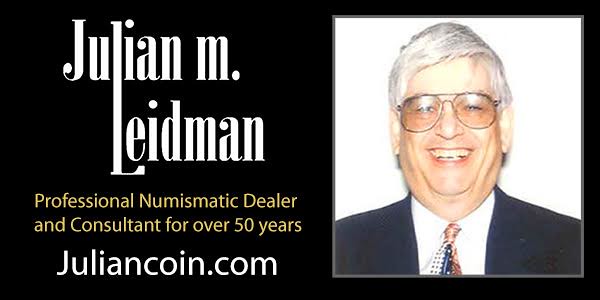
JONAS ADLER
Jonas Adler AKA Joseph Jonas Adler (1859-?), was born on April 23, 1859, at Cincinnati, Ohio of Prussian-German Jewish immigrant parents, Heinrich "Henry" Adler, a metalworker. Jonas entered the metalworking trade and worked as a brass finisher and tinner or tinsmith. However, we do not find his father Henry Adler, a metalworker, listed in Cincinnati City Directories 1859-1861.
Adler, Jonas, Pittsburg, Pennsylvania. Coin dealer, swindler. He issued a Fixed Price Catalogue in 1879. On February 21st, 1879, he was proposed as a member of the Western Pennsylvania Numismatic Society. Adler was a part-time coin dealer who would later catalog an auction sale of 225 lots of United States and Foreign Coins and Medals, at the D.F. Henry auction house at Pittsburgh, Pennsylvania, on April 30, 1879.
Though he was a proposed member of the Western Pennsylvania Numismatic Society it ended as a status quo. "The President appointed Mr. J. E. H. Kelley as teller - a vote then being taken and Mr. Kelley announced that more than three (3) votes had been cast in the negative." Members Morgan, McKnight, Kelley, Gies, Sermin, Shipman, Kirk, Comingo, and Rode were present. Article VII of the Society Bylaws states that three negative votes shall prevent the election of a prospective member." Apparently he had already developed a reputation for himself. His coin sale of April 1879 would be his first and last auction.
Ed Frossard wrote in the July 1879 issue of Numisma:
"Dealers sending coins on approval to Mr. Jonas Adler, Pittsburgh, PA., will do well, if they wish to assure a safe delivery, to address the distinguished coin dealer in care of one of the Town Justices, or of the Sheriff of the County."
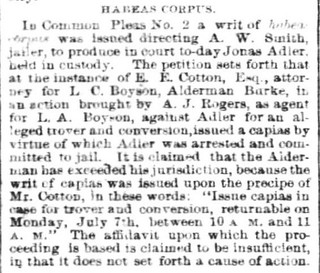 Fig. Arrest of Jonas Adler for taking property of E. E. Cotton. This is the case Ed Frossard referred to in Numisma. Pittsburgh Post Gazette, Thursday, July 3,
1879, page 2
Fig. Arrest of Jonas Adler for taking property of E. E. Cotton. This is the case Ed Frossard referred to in Numisma. Pittsburgh Post Gazette, Thursday, July 3,
1879, page 2
The September 1879 issue of Mason's Coin Collectors' Herald included an open letter to Adler:
"You seem to be doing a wholesale coin business on credit; but in reply to your many solicitations we say patronize those who give 30 days and send us cash at half price you pay on credit. Perhaps the credit system pays you best."
 Fig. Jonas Adler bought or attempted to buy coins pretending to be a member of the Numismatic Society of Pittsburgh. The Pittsburgh Daily Post, Saturday, March 6,
1880, page 3 The 1880 U. S. Census places him in Claremont Prison or Allegheny County Workhouse working as a tinner or tinsmith.
Fig. Jonas Adler bought or attempted to buy coins pretending to be a member of the Numismatic Society of Pittsburgh. The Pittsburgh Daily Post, Saturday, March 6,
1880, page 3 The 1880 U. S. Census places him in Claremont Prison or Allegheny County Workhouse working as a tinner or tinsmith.
The November 1884 issue of Numisma states:
"Jonas Adler, Pittsburgh, PA., has been rusticating at Claremont Springs, at municipal expenses for swindling a Fifth Ave., cigar dealer in a transaction of old coins. A.A.A. No. 1, first-class preferred petty swindler. Coin collectors, beware of Jonas!"
He was married on December 31, 1885, to Julia A. McCarthy (1864-). In 1887 the Pittsburgh City Directory lists him living at 74 River Avenue.
In 1888, Joseph J. Adler, a Tinner, lived at 60 Rush Street, Pittsburgh, Pennsylvania.
Another criminal record of his at the Allegheny County Workhouse cites his name as of J. J. Adler, Jewish, sentenced to two years for "False Pretenses" on November 7, 1888, shows he was released on August 26, 1890.
In 1907 the Pittsburgh City Directory lists a Joseph Adler, a Tinner, living at 60 1/2 Logan Street. Unfortunately another Joseph J. Adler, (1870-1924), born in Russia, also working as a Tinner, lived in Pittsburgh who arrived in the U. S. A. in 1904, making the distinction between the two difficult. The other Joseph Adler was married to Rebecca Fienstein and they had at least one son, Harry.
I first learned about Jonas Adler while researching and writing about the early history of the Western Pennsylvania Numismatic Society. Little else is known about him, but he must have been an "interesting character". There has never been a "Numismatic Society of Pittsburgh". At that time there was only WPNS, of which Adler was not a member. -Editor
To read the complete article, see:
ADLER, JONAS
(https://sites.google.com/a/numismaticmall.com/www/numismaticmall-com/adler-jonas)
For more information on WPNS, see:
The Early History of the Western Pennsylvania Numismatic Society (http://www.wpns1878.org/history.html)
The entire inventory of the Lupia Numismatic Library is for sale. Individual items will be available before the remaining archives are broken up into parcels sold at philatelic auctions in the U. S. and Hong Kong. Check NumismaticMall.com frequently as dozens of new items with estimates will be posted daily until everything is sold.
All inquiries will be given prompt and courteous attention. Write to: john@numismaticmall.com .
For more on Adler and the Western Pennsylvania Numismatic Society, see:
Wayne Homren Archives: The Early History of the Western Pennsylvania Numismatic Society
(https://nnp.wustl.edu/library/book/538820?page=14)
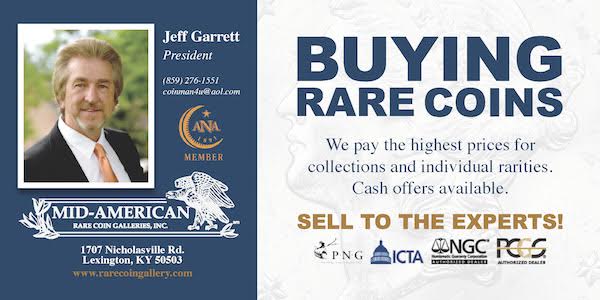
HARVEY STACK'S NUMISMATIC FAMILY, PART 34
Harvey Stack's blog series focuses on living in a numismatic family. Here is part 34. Thanks, Harvey! -Editor
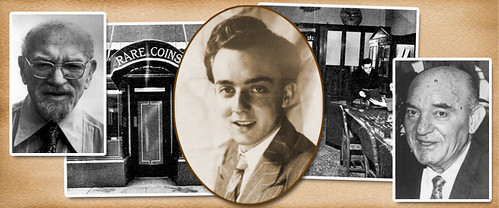
George Walton's collection was amassed during his travels mostly through the Mid-Atlantic States. He was an appraiser for banks and estates, and he traveled over a large area, meeting bank officers and collectors, private people who had coins for sale that were unknown to the general market.
George died in an automobile accident in the Carolinas in 1962. He generally carried parts of his collection in his car to show to clients he developed along the way, or to make dramatic displays at coin shows or conventions. He also had an unbelievable quantity of duplicates and was always able to do business as he traveled about. The Stack family had met George in about 1937, and saw him regularly as he visited New York about three or four times a year. He bought and sold from Stack's, as well as other dealers.
I can't remember the exact count but I know that George owned over 500 gold coins produced by the Bechtler family in all denominations and styles. He had a like quantity of Charlotte and Dahlonega mint coins. He loved private and territorial gold coins and also had a vast collection of such coins made in California, Oregon, Colorado and Utah.
He had a great affection for $50 gold "slugs," both octagonal and round. He rarely sold any of these as he had a competitive spirit and loved to show quantities at National Coin Shows. He and Amon Carter, Jr. used to show off their accumulations. I remember at one show in the 1950s Walton and Carter each displayed most of their $50 gold pieces. I was amazed that together they had on display at one time 101 pieces, 50 belonging to Amon Carter and 51 to George Walton. This was a dazzling display for sure, like seeing a Wells Fargo Chest of yesteryear. Carter said, "I could have brought more!” And Walton responded, “I could have brought more also!” They both laughed and went to the bar to have a drink together.
In those days collectors carried lots of coins to a show, competed with each other, were great friends and made collecting, trading, buying and selling, and learning from each other really fun.
Back now to George Walton. After the fatal crash, thousands of coins were scattered all over the highway. The police roped off the area and placed several guards along the highway while other officers searched the highway and the surrounding area for items that belong to George. After several days of searching the coins found were turned over to the Walton family. What they did not find was Walton's 1913 Liberty Head nickel, a great rarity. Another search followed and all that was found was a 1913 (altered date) Liberty Head nickel. Walton had planned to display the 1913 at a show he was attending that night, but probably took the replica rather than the original. The original was found by the family at his home decades later and thereafter was sold. However, as the real nickel was not found at the time, it was not included in Stack's offering of Mr. Walton's coins in 1963.
The first portion of the Walton sale took place in June 1963 and offered lower grade gold, silver and copper coins, 2164 lots, with many single coins and group lots. The second portion of the George Walton took place in October 1963 and contained an additional 3,400 lots! The total of the two sales were 5,564 lots!
This became one of the largest sales conducted in the decade. The fact that it contained so many duplicates allowed many collectors to get coins for their collections and dealers could enhance their stocks. We were even able to list and describe 27 different varieties of the Bechtler family coins. Stack's numbered each described variety with "S" numbers, and the design differences were fully illustrated and listed in the Guide Book of the following year. This required working a good number of evenings with my cousin, Norman, reviewing each coin to assign it a variety. Collectors, especially those who specialized in Southern gold coins, used the catalog to help them acquire these series in depth.
In addition to coins, Walton had an extensive collection of Southern paper currency, from broken bank notes to federal issues, which he also was able to acquire during his constant travels, in the same way he purchased coins.
The Walton Collection provided private and territorial coins to the Josiah K. Lilly Collection, as well as items for the Conrad Bolt Collection. Dr. Bolt was able to complete his collection from the Walton sales, and in 1966 Stack's was chosen to sell that collection. With the sales of the Samuel Wolfson Collection and the George Walton Collection in 1963, as well as an influx of buyers, Stack's had a major year of growth.
Of course, difficulties still remained in the numismatic hobby, mostly the attempts to enforce the new Gold Import Act, that made us quite dependent on what could be found in the American marketplace. This was true of across the entire market, and there was a lot of competition for numismatic items that were not subject to the import regulations. This pressure by the Treasury Department made the coins that were available more costly, and prices, especially of gold coins continued to rise.
To read the complete article, see:
Harvey Stack Remembers Growing up in a Numismatic Family, Part 34
(https://www.stacksbowers.com/News/Pages/Blogs.aspx?ArticleID=3223)
To read the earlier E-Sylum article, see:
HARVEY STACK'S NUMISMATIC FAMILY, PART 33 (https://www.coinbooks.org/v21/esylum_v21n51a14.html)

CHICAGO INDUCTS RIPSTRA INTO HALL OF FAME
The Chicago Coin Club has announced the first inductee into its Hall of Fame. -Editor
Chicago Coin Club Inducts J. Henri Ripstra into its Hall of Fame
The Chicago Coin Club announces that the first person to be inducted into its Hall of Fame is medalist and hobby leader J. Henry Ripstra, 1881-1961. His Hall of Fame citation has been published on the club's Hall of Fame web page, www.chicagocoinclub.org/projects/hof.
Twelve Hall of Fame inductees have been selected. Each of the remaining eleven will be announced at the rate of one per month, February through December, during the Chicago Coin Club's centennial year, 2019.
The Chicago Coin Club was organized in 1912 as American Numismatic Association Branch No. 1, and reorganized under its present name in 1919. All are invited to join. To become a member you must attend a meeting and submit an application along with a membership fee of $20 ($10 for Junior membership). A first reading of your application will be held at this meeting, and a second reading at the next monthly meeting, following publication of your name in the club newsletter. (You are not required to be present for the second reading.) Upon membership approval, you will become a member.
The Chicago Coin Club holds monthly meetings in downtown Chicago, plus at major numismatic conventions such as Central States, with a speaker featured at every meeting except the annual auction, held at the November meeting.
Here's the text of the Ripstra entry. -Editor
 J. Henri Ripstra was present at the meeting held in February 1917 to reorganize A.N.A. Branch No. 1, which had been moribund since its President died in 1914. Since
membership in this club was restricted to A.N.A. members, and there were other Chicago collectors who wished to join but were not A.N.A members, it was reorganized again two years
later to form the Chicago Coin Club. Mr. Ripstra received Charter Member number 9 when membership numbers were awarded to those who joined in February and March 1919, and he
remained a member the rest of his life. From 1933 to 1936 he served as President of the Club, and later as Director. He was a speaker at Club meetings many times.
J. Henri Ripstra was present at the meeting held in February 1917 to reorganize A.N.A. Branch No. 1, which had been moribund since its President died in 1914. Since
membership in this club was restricted to A.N.A. members, and there were other Chicago collectors who wished to join but were not A.N.A members, it was reorganized again two years
later to form the Chicago Coin Club. Mr. Ripstra received Charter Member number 9 when membership numbers were awarded to those who joined in February and March 1919, and he
remained a member the rest of his life. From 1933 to 1936 he served as President of the Club, and later as Director. He was a speaker at Club meetings many times.
Mr. Ripstra (Feb. 18, 1881 – May 4, 1961) was active in the American Numismatic Association also, serving on the Board of Governors for six years and then President, August 26, 1937, to October 5, 1939. He was elected to the ANA Numismatic Hall of Fame in 1978. In January 1939, he was appointed Honorary Chairman of the first meeting of what became the Central States Numismatic Society. While A.N.A. President, he was instrumental in the formation of the Iowa Numismatic Association.
A tool and die maker, Mr. Ripstra was also a highly talented medallic artist and die engraver. Before the Chicago Coin Club was formed he prepared the dies and struck medals for the Chicago Numismatic Society from 1908 through 1914, and produced dies for many other medals and numismatic badges. A collector of Lincolniana, he was the founder and Executive Secretary of the Lincoln Group of Chicago, of which Illinois Governor Henry Horner was Chairman; Ripstra's Lincoln portrait die for medals for the Lincoln Group was reused to strike medals for the 1965 Central States convention.
Many tributes poured in after his death. In the Numismatic Scrapbook for June 1961, Lee Hewitt (Hall of Fame No. 6) wrote, “With the passing of J. Henri Ripstra organized numismatics has lost one of its most colorful personalities. It was our privilege to know Henri for thirty-five years and, with the possible exception of Doug Ferguson, he was the best extemporaneous speaker and presiding officer that we have known in numismatic circles. He had an endless repertory of stories about the important numismatists of the early twentieth century such as Virgil Brand, Wm. F. Dunham, and Henry Chapman…” A.N.A. Past President V. Leon Belt wrote, “whatever honor I may have attained in both the American and Iowa Numismatic Associations was largely due to his assistance, encouragement, and support.” Wrote Harold R. Klein, A.N.A. Treasurer, “I have always enjoyed his warm personality as well as his sound counseling.”
(Image courtesy of ANA.)
To read the complete article, see:
Hall of Fame – Chicago Coin Club – Member 1 J. Henri Ripstra
(http://www.chicagocoinclub.org/projects/hof/m01.html)

ALEXANDER HAMILTON IN NUMISMATICS
Jennifer Gloede of the National Numismatic Collection published the article Hamilton: How money tells his story earlier this year on the National Museum of American History blog O Say Can You See. It was highlighted on December 14 among the blog's "American history must-reads of 2018" - Congratulations. -Editor
 In 1789, when Alexander Hamilton began his role as the first United States Secretary of the Treasury, he may still have been “young, scrappy, and hungry,” as the lyrics
go. Today, however, he would be over 260 years old. While many have discovered an interest in Hamilton's life through Lin-Manuel Miranda's Hamilton: An American Musical, my
connection with this founding father can be found in banknotes portraying his likeness and his role in our nation's monetary history. As a member of the museum's National
Numismatic Collection team, I'm not throwing away my shot to share this side of Hamilton's story with you.
In 1789, when Alexander Hamilton began his role as the first United States Secretary of the Treasury, he may still have been “young, scrappy, and hungry,” as the lyrics
go. Today, however, he would be over 260 years old. While many have discovered an interest in Hamilton's life through Lin-Manuel Miranda's Hamilton: An American Musical, my
connection with this founding father can be found in banknotes portraying his likeness and his role in our nation's monetary history. As a member of the museum's National
Numismatic Collection team, I'm not throwing away my shot to share this side of Hamilton's story with you.
President George Washington appointed Hamilton as the first United States Secretary of the Treasury in 1789, a position Hamilton held until 1795. During his term, Hamilton set up America's financial system, favoring a strong central government. This made him unpopular with some of his contemporaries, including Thomas Jefferson and James Madison, who favored state government.
Despite opposition, Hamilton called on Congress to establish a national bank and the U.S. Mint. His policies, based on the Bank of England and European economic systems, became the foundation of United States economics. After leaving office, Hamilton returned to his law practice and continued to be influential in politics until 1804, when he was shot by Aaron Burr in a duel and died from his wounds.
President George Washington appointed Hamilton as the first United States Secretary of the Treasury in 1789, a position Hamilton held until 1795. During his term, Hamilton set up America's financial system, favoring a strong central government. This made him unpopular with some of his contemporaries, including Thomas Jefferson and James Madison, who favored state government.
Despite opposition, Hamilton called on Congress to establish a national bank and the U.S. Mint. His policies, based on the Bank of England and European economic systems, became the foundation of United States economics. After leaving office, Hamilton returned to his law practice and continued to be influential in politics until 1804, when he was shot by Aaron Burr in a duel and died from his wounds.
Here are a couple of the portraits of Hamilton illustrated. -Editor
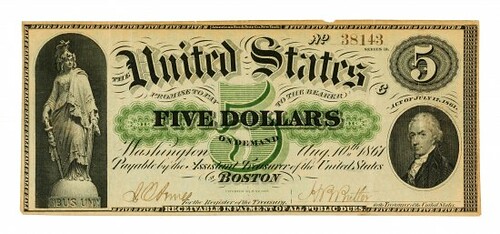
1861 $5 Demand Note
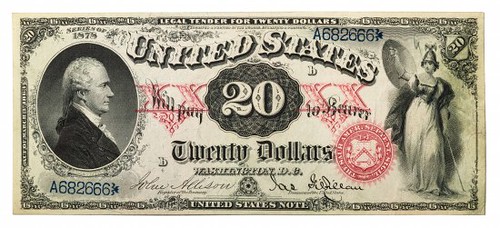
1878 $20 Legal Tender note
To read the complete article, see:
Hamilton: How money tells his story
(http://americanhistory.si.edu/blog/hamilton-how-money-tells-his-story)
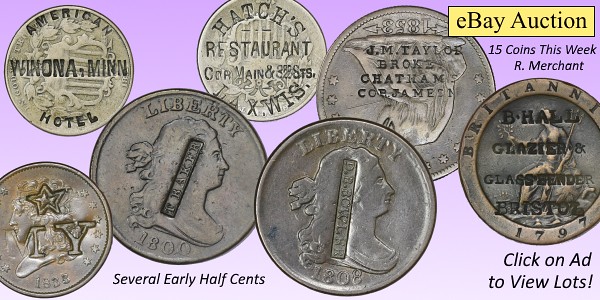
THE 1914 MILLION-DOLLAR ANS COIN EXHIBIT
American Numismatic Society librarian David Hill published a nice article on the fabled 1914 ANS exhibit in the 2018 Issue 3 of ANS Magazine. With permission, here's an excerpt describing some of the highlights of the exhibit. See the complete article for the story of how dealer Henry Chapman stirred up trouble trying to settle a beef with one of his customers. -Editor
The Million Dollar Exhibition of 1914 and the Time Henry Chapman Almost Got Kicked out of the ANS
They called it the Million Dollar Exhibition—well, at least that's what big-time numismatic showman Farran Zerbe said they called it, this eye-popping assemblage of numismatic delights put together by the ANS in 1914. It was an overview of United States coinage, illustrated by some of the choicest examples and arranged to coincide with the Society's 56th annual meeting. The show had been announced a year earlier, as the ANS reveled in the glorious success of its Joan of Arc exhibition, an event warmly covered in the press that had brought nearly 9,000 visitors uptown to see it.
The Society contributed a few items for the 1914 display, but private collectors were responsible for most of it (though a few of the delicacies on view would eventually come to rest in the Society's cabinet). As the show was set to wrap up that February, ANS officers and staff were likely feeling the satisfied tingle of another job well done—at least until Henry Chapman showed up looking to settle an old score against one of the other exhibitors.
In all, twenty-seven collectors had loaned their coins. In addition to the well-known dealer Chapman, these included numismatic author and future U.S. treasury secretary William Woodin and his famous patterns; the German-born Carl Wurtzbach of Massachusetts, with his colonials, Washingtons, early patterns, and large cents; and Judson Brenner of Ohio, who lent 450 minor patterns, as well as an original Confederate cent and its dies. Zerbe's contribution was error coins—or “freaks,” as they were known—and some mistrikes.
Major highlights came courtesy of James Ellsworth, the wealthy coal mine owner (and father of polar explorer Lincoln Ellsworth). Along with a Brasher doubloon (the Stickney specimen), he lent his four unique silver nova constellatio patterns, fascinating artifacts of a proposed Confederation-era coinage struck in the denominations of mark, quint, and cent (or bit).
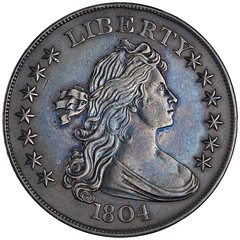
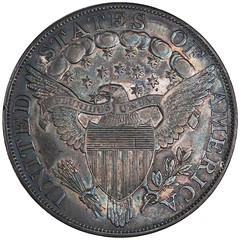
Figure 2
And then there were the 1804 dollars. Today, visitors to the Smithsonian's Gallery of Numismatics can pull out a drawer and behold three of the 15 known specimens of this rarity. This exhibit went one better by presenting four of them, two of which were Ellsworth's. One of these Ellsworth specimens eventually found its way into the ANS cabinet (fig. 2). After Ellsworth had parted with the coin, it changed hands a few more times, eventually coming to rest with Zerbe, who in the 1920s added it to his Money of the World exhibition, a traveling road show, mostly set up in bank lobbies, that would eventually settle down in New York City as the Chase Bank Money Museum. When the museum closed in 1978, most of the collection was transferred to the Smithsonian, but the 1804 dollar and some other pieces were given to the ANS.
The ANS's 1804 dollar is the Rosenthal specimen. (The catalog for the 1914 show has it as “Rosenberg,” a mistake repeated in the Numismatist review of the exhibit. Howland Wood was still referring to it as “Rosenberg” 10 years later.) The Rosenthals, Philadelphia scrap metal dealers, had acquired the coin from a business associate, W. Julius Driefus, who had supposedly gotten it from a former slave (though that part of the story doesn't really withstand serious scrutiny). Isaac Rosenthal is always identified as the owner of the coin, since he handled the transactions, but when discussing its ownership in a letter to Ellsworth (fig. 3), he says “we”—meaning him and his brothers Henry and Archibald—and he signs off with the company name, Jos. Rosenthal's Sons, all suggesting the coin was owned collectively. Isaac had written to Ellsworth to persuade him to keep the details of the transaction a secret. “We wish you would not tell anybody what you paid us for the 1804 dollar,” he said, “as we could have sold it for a good deal more money.” It must have gone for less than $1,000, since he told Ellsworth that at that amount “we could have sold it twenty times… and can get you now that price.”
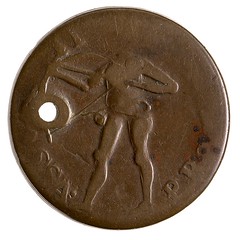
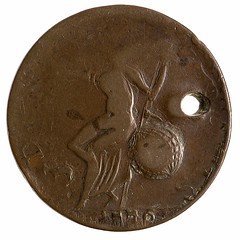
Figure 4
A colonial Massachusetts pattern was another of the displayed rarities (in fact it is unique) later acquired by the ANS (fig. 4). Its existence was first announced by soon- to-be-ANS-curator Howland Wood in the Numismatist in 1911. It has an American Indian on the obverse and Liberty on the reverse and was overstruck on a 1747 George II halfpenny. Some of the features of the original coin are still visible, including the BERN in HIBERNIA, the II of George II, and the outline of the king's head. This and two other stylistically similar patterns are said to have been the work of Paul Revere. Wood donated the coin to the ANS in 1917.
Fig. 2: United States. AR dollar, 1804. (ANS 1980.66.1, gift of Chase Manhattan Bank of North America). The ANS's 1804 dollar is the “Driefus-Rosenthal Specimen.”
Fig. 4: Massachusetts. AE 1/2 penny, attributed to Paul Revere. (ANS 1917.136.2, gift of Howland Wood), 27 mm.
For more information on the American Numismatic Society, see:
http://numismatics.org/
PNG ESTIMATES $4 BILLION 2018 U.S. COIN MARKET
The Professional Numismatists Guild published a press release this week highlighting the volume of sales in the numismatic market in 2018. We don't ordinarily discuss pricing, but it's an interesting view of the state of the hobby. While local coin shops, coin shows and club are stagnant or declining, the market marches on. -Editor
U.S. rare coin market was over $4 billion in 2018

Quality was in the eyes of the bidders in the multi-billion dollar United States rare coin market during 2018, according to a year-end tabulation conducted by the Professional Numismatists Guild (www.PNGdealers.org), a nonprofit organization composed of many of the country's top rare coin and paper money dealers.
While prices declined during the year for some U.S. coins in easily available lower grades, hundreds of noteworthy coins from early American to modern that are among the finest known of their kind set auction price records.
Based on responses to a year-end PNG questionnaire, the aggregate prices realized for all U.S. coins sold at major public auctions in 2018 totaled more than $345 million, compared to $316 million in 2017. The PNG estimates the overall U.S. rare coin market in 2018 was over $4 billion not including sales by the United States Mint or bullion coins, such as gold and silver American Eagles.
“With the stock market dropping during the fourth quarter of 2018 we saw an increase in interest in the rare coin market with some people taking profits from stocks and buying coins that have proven to show sizeable and consistent increases in value over the years, as well as buying precious metals,” said Professional Numismatists Guild President Barry Stuppler.
Four significant, historic vintage U.S. coins and three 19th century U.S. bank notes sold for $1 million or more each during the year in public auctions, and several other U.S. rare coins reportedly were purchased for $1 million or more in private transactions.
“There was continuing strong demand in the numismatic market on superb quality and rarity throughout the past year. In addition to high-grade vintage coins that set records, some modern coins that are the finest known, what we call ‘condition rarity,' also commanded amazing prices,” explained Stuppler.
One of those examples is a 1987-dated Kennedy half dollar graded by Numismatic Guaranty Corporation as Mint State 68 (on a scale of 1 to 70) which sold for a record-smashing $4,800 in a Stack's Bowers Galleries auction. A similar 1987 half dollar, graded by Professional Coin Grading Service also as MS 68, sold in 2014 for $3,290 by Heritage Auctions, an increase of over 45 percent in only four years. In circulated condition, 1987 Kennedy half dollars are simply worth face value, 50 cents each.
Among the most popular U.S. coins are Morgan silver dollars, struck from 1878 to 1904 and again in 1921, and named after their designer, George T. Morgan. An 1897-dated Morgan dollar struck at the New Orleans Mint and graded PCGS MS 66 was sold by Sotheby's in 2018 for a record $262,500. The same coin sold in 2015 in a Legend Rare Coin Auctions sale for a then-record $108,688, an increase of over 140 percent in three years.
The U.S. coins that each sold at auction for $1 million or more in 2018 were:
• $4,560,000 by Stack's Bowers for the finest example of one of the five known 1913 Liberty Head nickels, graded by PCGS as Proof 66, the highest price ever paid at auction for one of these legendary rare coins;
• $2,640,000 by Heritage Auctions for an original 1804 silver dollar, graded PCGS Proof 62;
• $2,160,000 by Heritage Auctions for the recently discovered fourth known 1854 San Francisco Mint Half Eagle ($5 denomination gold coin), graded NGC Extremely Fine 45;
• and $1,740,000 by Heritage Auctions for a 1792 Washington Eagle ($10 denomination gold coin), graded NGC Extremely Fine 45.
The auction firms that responded to a PNG year-end questionnaire are: Archives International Auctions; Ira & Larry Goldberg Auctioneers; GreatCollections Coin Auctions; Heritage Auctions; Kagin's, Inc.; David Lawrence Rare Coins; Legend Rare Coin Auctions; Sotheby's; and Stack's Bowers Galleries.
The Professional Numismatists Guild was founded in 1955, and its member-dealers must adhere to a strict code of ethics in the buying and selling of numismatic merchandise.
For additional information and a list of member-dealers, visit online at www.PNGdealers.org or call the PNG headquarters in Temecula, California at (951) 587-8300.
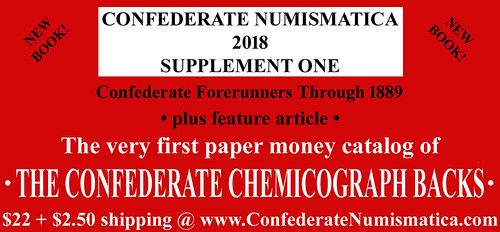
DR. KAVAN RATNATUNGA, ASTRONOMIC NUMISMATIST
I met longtime E-Sylum contributor Dr. Kavan Ratnatunga many years ago when we were both members of the Pittsburgh Numismatic Society. An astrophysicist, he was working nearby at Carnegie Mellon University. He later returned home to Sri Lanka where he continued developing his collection and web site of Sri Lankan coinage. Kavan was recently interviewed by Roar Media and the article and a YouTube video are available online. Here's an excerpt from the article. -Editor

Dr. Kavan Ratnatunga
With its robust history, Sri Lanka has rich pickings for numismatists. Coins in Sri Lanka date back to punch-marked coins from 500 BCE, with many more varieties in the centuries since then. Coins are often found from excavations at historical sites or when previously unused government land is opened up for development. For example, many coins and artefacts from the Kingdom of Ruhuna, which was in the south-east of Sri Lanka, were discovered when areas previously protected by the jungle just outside the Yala wildlife sanctuary, were opened up for village cultivation in the early 1980s by then Prime Minister R. Premadasa. Villagers digging the land started finding various ancient artefacts, including coins.
For anyone who wants to begin coin collecting, there are numerous books published on the subject. There is also the the Sri Lanka Numismatic Society that began in 1976 for coin collectors in Sri Lanka. Now, they meet on the third Sunday of each month at the Royal Asiatic Society, a part of the Mahaweli Centre in Colombo 7. One of the society's most illustrious members and foremost numismatists is Dr. Kavan Ratnatunga. We spoke to Dr. Kavan, who enlightened us on the the state of coins as artefacts in the country.
Despite his extensive knowledge of coins, Dr. Kavan's initial claim to fame is as an astrophysicist. After studying for his Ph. D at the Australian National University, he joined several other renowned institutes around the world, such as the Institute for Advanced Study in Princeton (famed for being the academic home of Albert Einstein, after his immigration to the United States), the Dominion Astrophysical Observatory in Canada, NASA's Goddard Space Flight Centre, the Space Telescope Science Institute and Johns Hopkins University. In 1992, he joined the Hubble Telescope Project and later researched data from the Hubble telescope at the Carnegie Mellon University, where he made several discoveries.
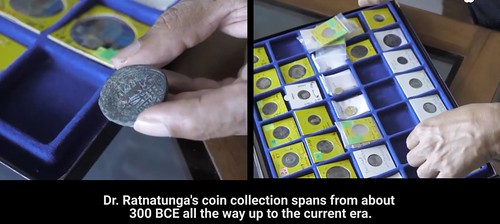
Dr. Kavan explained that his love of coins, much like his love of astronomy, also began at a young age, when his father and grandfather casually collected and passed down some coins to him. But his own collection only truly began around 1993, when he attended a coin show in Baltimore, at which a seller from Spink, a reputed auction and collectibles company based in London, was offering 11th Century gold coins from Sri Lanka.
“It was the first time that I realised that I could buy one of these and own an 11th Century gold coin from Sri Lanka,” he said. “So, my question to him was, ‘How do I know that it's authentic?', because I couldn't believe that this guy [had this]. He looked at me and said, ‘We are Spink of London, founded in 1666. Why are you asking us that stupid question?' Anyway, I took his word for it [and] bought the coin. I realise now, with more knowledge after 20 years, that the coin he did sell me was a fake,” he said with a laugh. “I have actually published on my website reasons why I think that particular old coin is a fake.”
Walking into Dr. Kavan's home is like walking into a museum gallery, with statues and artefacts at every corner. These include a to-scale Lego replica of a Saturn V rocket and an ancient grinding stone from the Anuradhapura era. A carving of a design from an ancient Elephant and Swatika coin adorns his doorway. Dr. Kavan's collection spans from 300 BCE to the current era, and it is extensively documented on his website on coins—lakdiva.org—where over 1,000 Sri Lankan coins have been documented.


To read the complete article, see:
Shortchanging Our Past: A Conversation On
Coin Collecting With Dr. Kavan Ratnatunga (https://roar.media/english/life/in-the-know/shortchanging-our-past-a-conversation-on-coin-collecting-with-dr-kavan-ratnatunga/)
To watch the video, see:
The Astronomic Numismatist (https://www.youtube.com/watch?v=yYW_Zj97gLw)
To visit Kavan's web sites, see:
http://coins.lakdiva.org/
http://notes.lakdiva.org/
THE BOOK BAZARRE
STEPHEN ALBUM SALE 33 JANUARY 2019
Here's the press release for next month's sale from Stephen Album Rare Coins. These are only a few highlights, so be sure to check out the full catalog online for much more. -Editor
Stephen Album Rare Coins will hold its Auction 33 on January 17-19, 2019 on location in Santa Rosa, California. Lot viewing will be available at the New York International Numismatic Convention (NYINC) from January 10-13. The auction is comprised of 2,620 lots of Ancient, Islamic, Chinese, General World, and Indian Coins. Some featured groups in the sale include a nice collection of coins of Poland, a number of rare grade Russian coins, many Chinese rarities, as well as a vast number of early Islamic silver and gold. Some highlights from the sale follow:
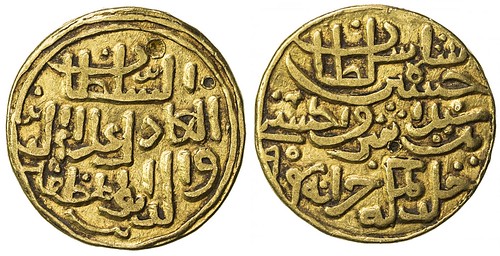
Estimated at $30,000 to 35,000
This is clearly a special presentation issue, almost perfectly centered and with complete borders on both sides. The standard gold tankas of the later sultans of Bengal, including Hussain Shah, were struck on planchets that were not as wide as dies.
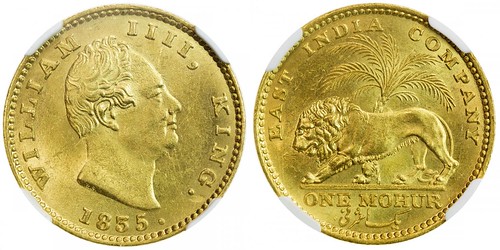
LOT 1607
BRITISH INDIA: William IV, 1830-1837, gold mohur, 1835(c), KM-451.2, S&W-1.9, East India Company issue, R.S. incuse on truncation, lion standing left before palm tree, a
superb example with brilliant lustrous fields, amongst the finest we have handled! NGC graded MS63.
Estimated at $19,000 to 21,000
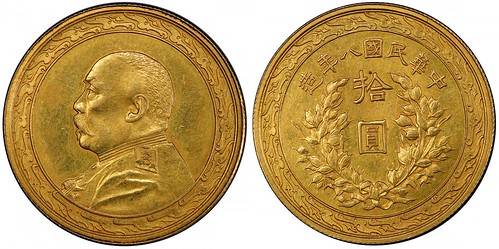
LOT 1805
CHINA: Republic, gold 10 dollars, Tientsin mint, year 8 (1919), Y-330, L&M-1030, Yuan Shi Kai, dies engraved by Luigi Giorgi, PCGS graded MS62, RR.
Estimated at $18,000 to 25,000
These gold coins were struck in 1919 during a brief attempt to reintroduce gold coinage. The plan never fully materialized, and essentially all of the small mintage of 10 and 20 dollar pieces vanished from circulation. Many of those that appear on the market were not carefully handled, and show evidence of cleaning or mishandling. This lovely example is an exception.
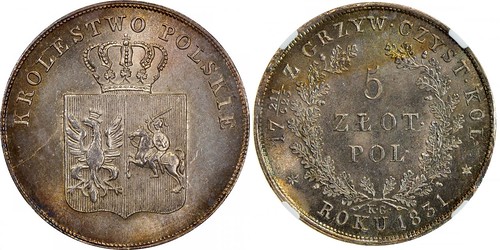
LOT 2216
POLAND: November Uprising, 1830-1831, silver 5 zlotych, Warsaw mint, 1831, Cr-124, mintmaster KG, a superb example! next highest graded is MS62, NGC graded MS66. Finest graded
by either NGC or PCGS.
Estimated at $3,000 to $5,000
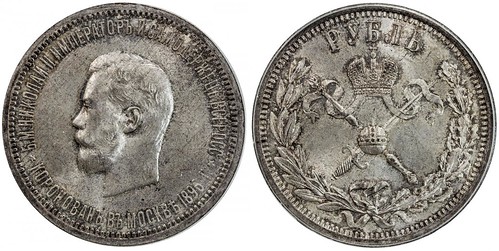
LOT 2255
RUSSIAN EMPIRE: Nicholas II, 1894-1917, silver rouble, 1896, Y-60, Dav-294, Bitkin-322, Coronation of Nicholas II, with custom wooden case from the Goodman Collection, an
exceptional quality example with golden tone around the periphery and bright clean surfaces, PCGS graded MS65 , ex Irving Goodman Collection of Russian Coinage.
Estimated at $4,500 to 5,500
Also, on January 20 will be the firm's first Internet-Only Auction, comprised of 500 lots of items estimated at $30 to $1000. Bidders who register online for Auction 33 will be automatically registered for bidding in this inaugural Internet-Only Auction #1.
The firm is now seeking consignments for its Auction 34 on May 23-24, 2019. More information can be found on their website at www.stevealbum.com .

NUMISMATIC NUGGETS: DECEMBER 30, 2018
Here's a selection of interesting or unusual items I came across in the marketplace this week. Tell us what you think of some of these. -Editor
1686 Netherland 14 Stuivers
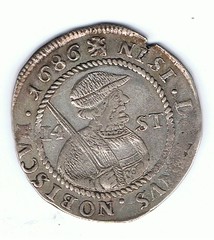
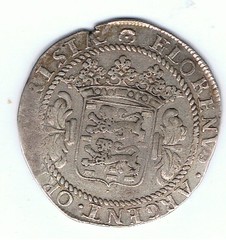
Nice example of an early modern coin. -Editor
To read the complete lot description, see:
Netherlands - Friesland - 14 Stuiver 1686 - Silver
(https://auction.catawiki.com/kavels/23278185-netherlands-friesland-14-stuiver-1686-silver)
1771 Five Shillings North Carolina Note

Early American currency went through several stages of development in colonial and post-Revolutionary history of the United States. Because few coins were minted in the thirteen colonies that became the United States in 1776, foreign coins like the Spanish dollar were widely circulated. Colonial governments sometimes issued paper money to facilitate economic activity. During the American Revolution, the colonies became independent states; freed from British monetary regulations, they issued paper money to pay for military expenses. The Continental Congress also issued paper money during the Revolution, known as Continental currency, to fund the war effort. One by one, colonies began to issue their own paper money to serve as a convenient medium of exchange. In 1690, the Province of Massachusetts Bay created "the first authorized paper money issued by any government in the Western World."
This paper money was issued to pay for a military expedition during King William's War. Other colonies followed the example of Massachusetts Bay by issuing their own paper currency in subsequent military conflicts.
U.S. colonial currency is a pleasure to collect - such history to start with, together with ample evidence that these notes circulated widely during their day. Who needs pristine examples when you can hold in your hands a bill that passed in commerce over two hundred years ago? -Editor
To read the complete lot description, see:
1771 Five Shillings North Carolina Colonial Currency Note
(https://www.pristineauction.com/a1827531-1771-Five-Shillings-North-Carolina-Colonial-Currency-Note)
1922 $500 Gold Certificate
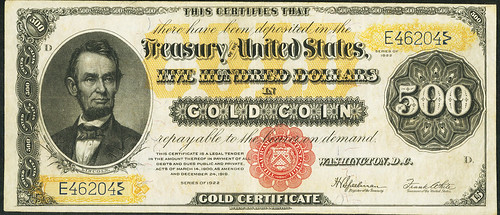
This $500 Gold Certificate is perhaps the nicest for the grade that we have seen. The face is uninterrupted by the few folds and modicum of circulation that account for the Very Fine grade. The colors are perfect and bright on front and back, set over creamy and bright paper.
A great example of a seldom-seen note. From the Heritage January 2019 Currency auction. -Editor
To read the complete lot description, see:
Fr. 1217 $500 1922 Gold Certificate PCGS Very
Fine 30.. (https://currency.ha.com/itm/large-size/gold-certificates/fr-1217-500-1922-gold-certificate-pcgs-very-fine-30/a/3571-21150.s)
Enrico Saroldi Maternity Medal
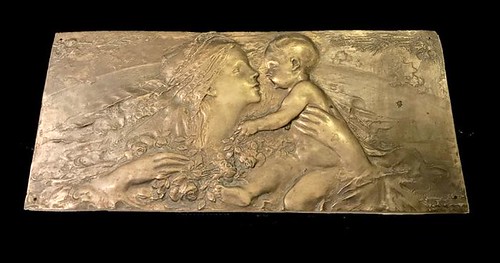
Italy - 1920-1949 - Bronze
Object: Maternity - Bas-relief in bronze
Material: Bronze
Designer/ Artist: Enrico Saroldi (1878-1954)
Period: 1920-1949
Country of Origin: Italy
Condition: Excellent condition - barely used with minimal signs of aging & wear
Dimensions: 22×49×0.5 cm
Weight: 4 kg
Enrico Saroldi (Carmagnola, March 19, 1878 - Milan, 1954) was an Italian sculptor. A pupil of E. Butti at the Brera Academy of Fine Arts in Milan, he was the author of numerous public monuments, sepulchral works, bas-reliefs, busts, portraits and medals. He also designed some coins.
A bronze bas-relief triptych from the same period is present at the Pio Albergo Trivulzio in Milan.
An issue of the monthly magazine ‘A B C Rivista d'arte' was dedicated to Saroldi. (A B C Tipo A.R.S. A. publishing house Roto press) 1932-37, Turin.
The bas-relief is made of bronze, and is in excellent condition.
Size: 48.5 x 22 x 5 cm. Weight: 4 kg.
Great plaquette, nicely catalogued by the seller. -Editor
To read the complete lot description, see:
Enrico Saroldi (1878-1954) - Maternity - Bas-relief in bronze
(https://auction.catawiki.com/kavels/22395549-enrico-saroldi-1878-1954-maternity-bas-relief-in-bronze)
Calvin Coolidge Memorial Award Medal

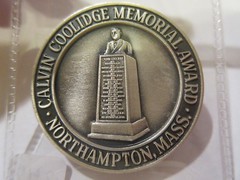
Description: 1984 Distinguished Citizen of the Year "Hon Silvo Conte" 1 oz Sterling Silver Medal - BU
I can't say I've ever heard of the Calvin Coolidge Memorial Award medal before. -Editor
To read the complete lot description, see:
Lot 245: 1984 Distinguished Citizen of the Year "Hon Silvo Conte" 1 oz Sterling Silver Medal - BU
(https://www.invaluable.com/auction-lot/-1-c-9A746D7B28)
Deluxe Leather Hettrich-Guttag
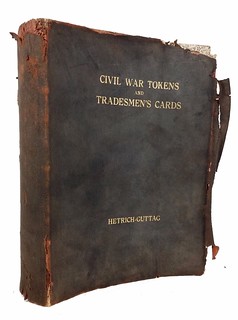
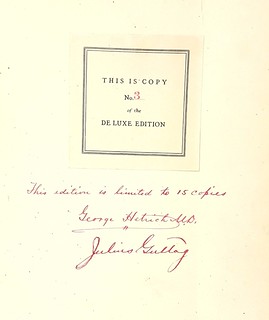
Subject: Military & War
Topic: Civil War (1861-65)
Binding: Leather
Original/Facsimile: Original
Publisher: Self Published
Special Attributes: 1st Edition, Limited Edition, Signed
Year Printed: 1924
Author: George Hetrich
Place of Publication: Kutztown, PA
Language: English
HETRICH, George and GUTTAG, Julius. Civil War Tokens and Tradesman's Store Cards: A Tentative List of the Civil War Tokens, and Store Cards issued by the Merchants of the United States and Used as Money During the Period from 1861 to 1864.
[Kutztown, PA]: Hetrich & Guttag, 1924. Limited Edition, SIGNED by both authors on flyleaf with written note "This edition is limited to 15 copies" and numbered "No. 3 of the De Luxe Edition" on paper title card above. Large octavo (9.5" x 7"); 289p. 16 linen-backed color example plates. Eratta tipped in at front. Limp suede covers with yapp edges and gilt lettering. Expected deterioration to suede, with a good bit of rubbing and fraying along edges, joints, and spine ends, along with a general "dusting" away of leather upon handling (book now stored in a clean poly bag). Vertical creasing about two inches in on initial pages. Binding is sound and pages unmarked. Not an ex-library copy.
Adrian Gonzalez Salinas of Monterrey, Mexico came across this offering of a rare deluxe leather edition of Hettrich-Guttag, not in the best condition. Thanks. -Editor
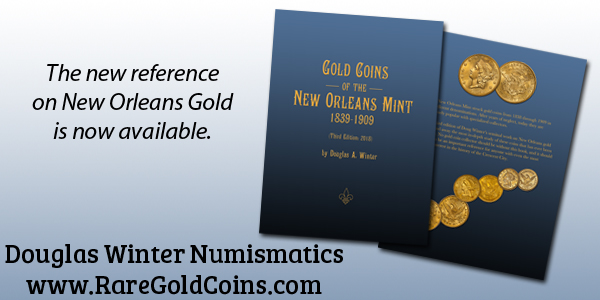
CZECH REPUBLIC GOLD COIN FIND
Found via The Explorator newsletter: an article about a nice gold coin find in the Czech Republic. -Editor
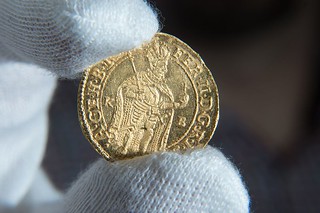 Officials of the Pardubice region recently announced a surprise discovery. Dozens of gold coins were found on a pasture near the town of Králíky in the north
east of Bohemia. Experts, who have analysed the coins, say they date to the period of the Thirty Years' War and may have been buried while an army was on the march.
Officials of the Pardubice region recently announced a surprise discovery. Dozens of gold coins were found on a pasture near the town of Králíky in the north
east of Bohemia. Experts, who have analysed the coins, say they date to the period of the Thirty Years' War and may have been buried while an army was on the march.
An unnamed individual found 60 coins partly buried on a pasture. The discovery was immediately reported and, before publicising the information earlier this week, local experts were asked to look at the objects.
One of them is archaeologist David Vích from the Vysoké Mýto Regional Museum. He says the youngest coin dates back to 1631, which suggests the items were likely buried sometime between the mid- to late-period in the war. The region of Pardubice was threatened multiple times during these phases of the conflict, especially by Swedish forces.
“The Thirty Years' War was a very dramatic period when things were often buried underground and not collected afterwards. Because this is quite a large amount of money, whose composition points to its origins somewhere in the region of Hungary, we may go so far as to hypothesise that it is related to a marching army, or some sort of military action.”
The coins, one of which weighs more than three grams, were likely to have been placed in a leather or textile pouch which rotted away over time.
Aside from Hungarian coins, there are also pieces from Poland, the Netherlands and Turkey. Most are made out of gold with a high purity.
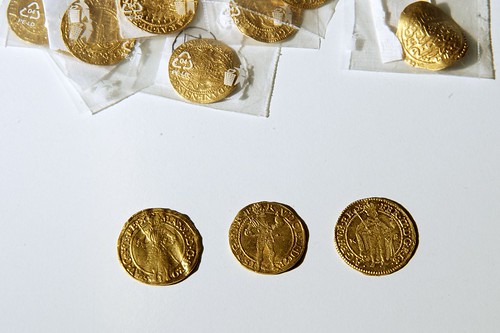
To read the complete article, see:
GOLDEN TREASURE FROM THIRTY YEARS' WAR DISCOVERED IN
PARDUBICE REGION (https://www.radio.cz/en/section/curraffrs/golden-treasure-from-thirty-years-war-discovered-in-pardubice-region)

AMERICAN BANK NOTE BAKER STREET IRREGULARS TRAYS
Greg Ruby publishes The Fouth Garrideb blog on the numismatics of Sherlock Holmes, and his November 27, 2018 post discusses interesting American Bank Note Company items related to the dinner of the Baker Street Irregulars. -Editor
One gentleman who attended the 1940 BSI Dinner was Allan M. Price, Manager of Domestic Sales for the American Bank Note Company. Price had attended the two previous BSI Dinners in 1934 and 1936, and would attend the next one in 1941. Price was also a member of Morley's Three Hours for Lunch Club, which was a predecessor to the BSI. Price would pass away on February 16, 1943.
Now, let's move ahead 73 years — Saturday, January 12, 2013, to be precise. The annual dinner of the Baker Street Irregulars held at the Yale Club in New York City is just one event in what is now referred to as the Sherlock Holmes Weekend, which runs from Wednesday through Sunday. The dinner (now with 160 attendees) is followed by a market on Saturday, at the Roosevelt Hotel, where vendors sell books, collectibles and other items of Sherlockiana to the several hundred who trek to New York for the weekend.
One vendor, Javier Doria, a dealer of antiquities from Madrid, had a flurry of activity at his table in the Merchants Room. He was offering for sale two brass “plates” with symbolism found on U.S. currency, along with images and emblems of Sherlock Holmes. Both plates were mounted on wooden plaques, one with handles, giving it the appearance of a serving tray. Each references the January 30, 1940, BSI dinner, while the second plate also indicates that it was presented in Toronto on July 11, 1940.
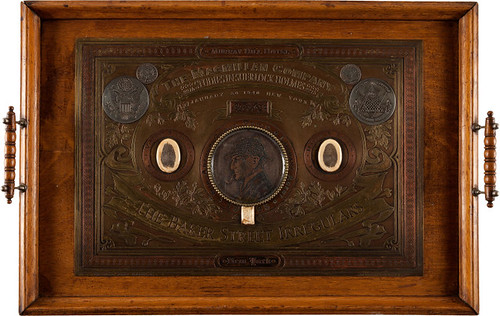
The “New York” plate, with handles. Photograph courtesy of Heritage Auctions. I call this first plate as the “New York” plate and will refer to the second as the “Toronto” plate. The “New York” plate is mounted on a dinner tray, likely made of oak, and measures approximately 18.25 x 26.5 inches, with brass-and-wood handles at each end. The plate design features Holmes's profile, after a popular drawing by Frederic Dorr Steele (the illustrator of the Holmes stories appearing in Collier's), centered in a magnifying glass device, with the engraved thumbprints of “Partners in Crime” Vincent Starrett and Harold S. Latham (a trade editor at Macmillan) on either side. Reliefs of The Great Seal of the United States and the Annuit Cœptis seal found on the reverse of the United States one-dollar bill are at the upper corners next to the inlaid obverse and reverse of an 1895 Victoria shilling. At the upper center is “The Macmillan Company / 221b Studies in Sherlock Holmes 221b / January 30 1940 New York” and “The Baker Street Irregulars” is under Holmes's profile. Engraved along the bottom edge is “The Broad Street Irregulars – Lambie & Barrowman – American Bank Note Co.”
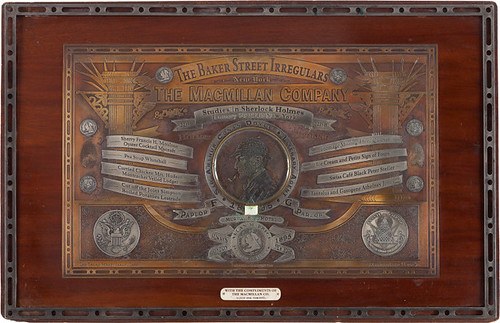
The “Toronto” plate Photograph courtesy of Heritage Auctions
The “Toronto” plate is mounted to a walnut board and measures approximately 19.5 x 29.5 inches. The plate design follows the same currency motif as its New York predecessor, with the same The Great Seal of the United States and the Annuit Cœptis, with six 1895 Victoria shillings inlaid (one of which is surrounded by the legend Allan M. Price / Holmes Maker). Centered on the plate is an engraving of Holmes in profile, after the popular drawing by Frederic Dorr Steele within a magnifying glass device surrounded by words “Sir Arthur Conan Doyle Literary Agent 1895.” At the upper center is “The Baker Street Irregulars / The Macmillan Company / Studies in Sherlock Holmes / January 30 1940” with “221 B” on either side of the date.
Surrounding the central Holmes figure are eight radiating lines, four per side, bearing the fancifully named dishes served at the BSI dinner such as Ice Cream and Petit Signs of Four. Further there is a larger medallion of Queen Victoria below the Holmes profile and two engraved fingerprints at the extreme right and left, unlabeled though likely belonging to Starrett and Latham, the “Partners in Crime” of the January 1940 plate. Mounted directly on the board beneath the plate is the label “With the Compliments of / The Macmillan Co. / 11 July 1940, Toronto.”
Until that Saturday in January 2013 in the Merchants Room, no one in the Sherlockian world was aware of these plates' existence. The minutes of the 1940 BSI Dinner make no mention of them. In writings about the BSI history, the 1940 dinner has been described at length (Arthur Conan Doyle's son, Denis, attended and was somewhat taken aback that his father was considered by the attendees to be the literary agent for Dr. Watson and not the author of the stories), and attendees were interviewed for their recollections. Once again, no mention of these plates appeared in those writings.
To read the complete article, see:
Sherlock Holmes and the American Bank Note Company Mystery
(https://fourthgarrideb.com/2018/11/27/sherlock-holmes-and-the-american-bank-note-company-mystery/)

MONEY ARTIST JOSH LEIDOLF, AKA TRAN$PARENT
Money is a universal theme, and artists turn to it again and again. My old friend money artist J.S.G Boggs was just one in a long line of artists including Andy Warhol who turned to money as a subject. Thanks to the December 25, 2018 issue of News & Notes from the Society of Paper Money Collectors, here is information about a new artist picking money as a theme. First up is a promotional press release issued in conjunction with the recent Miami Art Basel show. -Editor
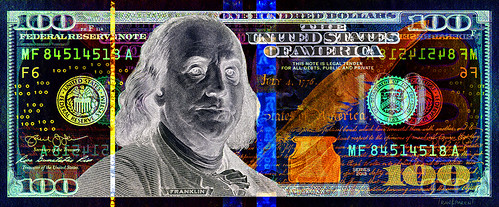
Last week at Miami's Art Basel, one of the world's largest and most prestigious art shows, ultra-fine money artist Josh Leidolf aka TRAN$PARENT, (@transparentartist on Instagram), absolutely stole the show. From hosting the opening party with local Miami Heat NBA superstar Dwyane Wade and 305 Films to collaborations with Lamborghini featured on an Italian Lire to charities and private installations at South Beach Hotels, Miami Penthouses and Wynwood Hotspots, TRAN$PARENT officially made his mark on the art world forever.
For an established artist, having one, two or even three art installations during Art Basel Miami is a blessing. TRAN$PARENT had FOURTEEN different exhibitions displaying his various domestic currency, international currency and cryptocurrency pieces. As an Art Basel Miami “first time artist” the world can't stop talking about TRAN$PARENT'S skillset, artwork, message and his work ethic.
TRAN$PARENT is turning a lot of heads in the art world. He specializes in all American paper currency denominations ranging from $1-$10,000 bills. But he doesn't just do his art with American currency. He uses foreign notes like British Pounds, European Euros, Chinese Yuans and Israeli Shekels. He is even doing his transparent art with Cryptocurrency. TRAN$PARENT is the only “money artist” on the planet depicting all three layers of the bill. This means, the front of the bill, the back of the bill and the middle security features typically hidden to the naked eye. He uses museum quality archival metallic papers press mounted in between fine art acrylic and aircraft aluminum in a gallery contemporary setting.
To read the complete press release, see:
Ultra Fine Money Artist Josh Leidolf AKA TRAN$PARENT Absolutely Takes Over This Year's Miami Art Basel - From Dwyane Wade To Lamborghini This Young Artist Is On Fire!
(https://www.prweb.com/releases/ultra_fine_money_artist_
josh_leidolf_aka_tranparent_absolutely_takes_over_this_year_
s_miami_art_basel_from_dwyane_wade_to_lamborghini_this_young_
artist_is_on_fire/prweb15992829.htm)
The following is from the artist's web site. -Editor
 Ultra Fine Money Artist TRAN$PARENT is an American based artist located in the Ft Lauderdale/Miami area. He is also an Entrepreneur, Humanitarian, World Traveler and
Journalist. While painting and drawing since an early age, collecting rare international currency and exploring creative photography in over 50 countries in his lifetime, he
always had the dream of making the world's currency as vibrant as the people who use it. He always felt like art should evolve with the times and with the people, so he set out to
do something revolutionary that no other money artist on the planet is doing.
Ultra Fine Money Artist TRAN$PARENT is an American based artist located in the Ft Lauderdale/Miami area. He is also an Entrepreneur, Humanitarian, World Traveler and
Journalist. While painting and drawing since an early age, collecting rare international currency and exploring creative photography in over 50 countries in his lifetime, he
always had the dream of making the world's currency as vibrant as the people who use it. He always felt like art should evolve with the times and with the people, so he set out to
do something revolutionary that no other money artist on the planet is doing.
He specializes in museum quality, ultra-fine money art. Specifically American denominations from the $1 to the $10,000 bill and with special granted requests the Million Dollar Bill. He also specializes in various rare and well known International currencies. Creating game changing revolutionary art has been his life's passion and he illustrates it beautifully in his TRANSPARENT artwork depicting the front, back and middle security features of his bills. His TRANSPARENT Art is actually a metaphor for being TRANSPARENT with your loved ones, with your business associates, but most importantly with yourself.
He fine tunes each image to ensure the highest possible vibrancy and each image is personally quality controlled by him and is also hand signed and individually numbered. APs to Limited Editions his pieces are completely breathtaking and pop when viewed under regular or proper lighting. His pieces are not easy to come by and are becoming highly sought after. One of his many accomplishments was successfully orchestrating 12 different beautiful installations of his work at Miami's Famous Art Basel 2018. His installations included being the featured artist at the opening night with the Miami Heat's Dwyane Wade and 305 Films at their Wynwood based studio, a private high net worth and celebrity exhibition in the $31 Million dollar Penthouse of the Porsche Design Tower, as well as several South Beach hotels including the National where he was commissioned by Lamborghini to do two custom pieces on an Italian Lire. Not to mention his crypto currency collection being unveiled at the Blockchain World Open and his philanthropic events at the Sagamore, the SLS and at Island Gardens for various known reputable charities. And how could we forget to mention the talk of the town all week, his beautifully wrapped 1 of 2 gorgeous Concept Hummer H1 cruising around Miami's hottest art districts and parked in front of the some of the most iconic hotels and art warehouses in the entire area for the entire week. Hard work pays off as TRAN$PARENT is already in discussion to do collaborations on clothing lines, cars, full buildings and various high end luxury products. Stay tuned.
His gorgeous museum quality fine money art displayed ornately framed and/or as a gallery contemporary hangs in the homes, businesses and yachts of affluent private collectors, celebrities, famous athletes, politicians and art enthusiasts across the nation. His clients include Dan Marino, Dwyane Wade, Pitbull, Gil Green, Chris Osceola, Indy Al Miller, multiple business owners and the famous wealth money manager to the stars Jeffrey M. Fratarcangeli. His first piece ever sold publicly went to one of the heads of the Seminole Indians and one of the owners of the Hard Rock Hotel and Casino brand for a very hefty sum. Since finally going public, he has sold numerous pieces and has donated his art, energy and effort to The Alzheimer's Association, Kids in Distress, Saving Lives in Israel, The Little Lighthouse Foundation, The Boys and Girls Club, The Dan Marino Foundation, The Special Olympics, NYC Bigs and Littles Mentoring Program, Charities to feed and educate underprivileged children in Haiti and Mexico, The Pancreatic Cancer and the Autism Foundations to name a few and his art has only escalated in value.
To visit the artist's web site, see:
https://themoneyartist.com/
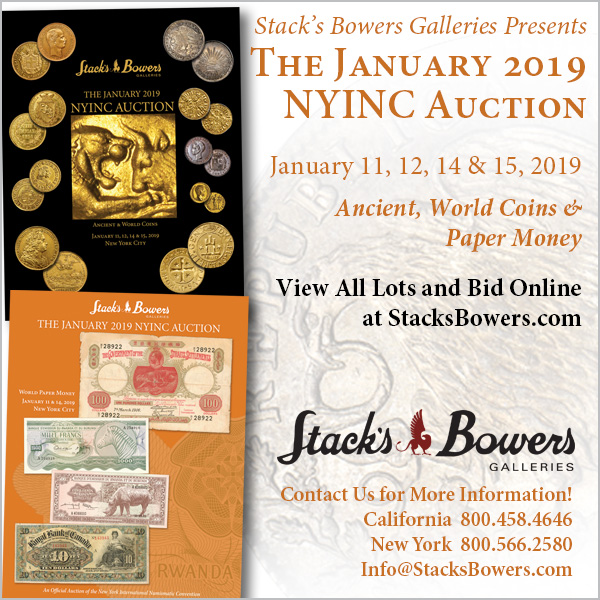
WSJ: YOUR CASH IS NO GOOD
The Wall Street Journal published a page-one article this weekend about the growing number of business establishments that refuse to accept cash in payment. Here's an excerpt. -Editor
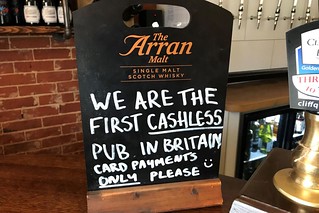 Sam Schreiber was mid-shampoo at a Drybar blow-dry salon in Los Angeles when someone from the front desk approached her stylist with an emergency: a woman was trying to
pay for her blow-out with cash.
Sam Schreiber was mid-shampoo at a Drybar blow-dry salon in Los Angeles when someone from the front desk approached her stylist with an emergency: a woman was trying to
pay for her blow-out with cash.
“There was this beat of silence,” says Ms. Schreiber, 33 years old. “She literally brought $40.”
More and more businesses like Drybar don't want your money—the paper kind at least. It's making things awkward for those who come ill prepared. After all, you can't give back a hairdo, an already dressed salad or the two beers you already drank.
The salad chain Sweetgreen has stopped accepting cash in nearly all its locations. Most Dig Inns—which serve locally sourced, healthy fast food—won't take your bills either. Starbucks went cashless at a Seattle location in January, and at some pubs in the U.K., you can no longer get a pint with pound notes. The practice of not accepting cash has become popular enough to catch the attention of American lawmakers.
Despite the popularity of debit- and credit-card transactions, plenty of people do still pay for things with actual money. Cash represented 30% of all transactions and 55% of those under $10, according to a Federal Reserve survey of 2,800 people conducted in October 2017.
Although U.S. bills feature the words, “This note is legal tender for all debts, public and private,” there's no federal law that says businesses have to accept cash, according to the Federal Reserve's website.
Massachusetts is the only state that currently requires retailers to accept cash. Some New Jersey legislators are working to make their state next. New York City Councilman Ritchie Torres of the Bronx recently proposed legislation that would prohibit retailers and restaurants from refusing cash, and city council members in Washington, D.C., and Philadelphia have proposed similar legislation.
“I refuse to patronize businesses that reject cash payments, even though I primarily use debit or credit,” says Councilman Torres. He says not accepting cash is discriminatory against the undocumented, people without bank accounts and credit cards, and those who wish to have their transactions be more private.
To read the complete article (subscription required), see:
Your Cash Is No Good Here. Literally.
(https://www.wsj.com/articles/your-cash-is-no-good-here-literally-11546013696)
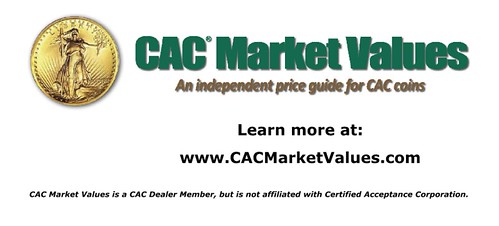
LOOSE CHANGE: DECEMBER 30, 2018
Here are some additional items I came across in the media this week that may be of interest. -Editor
Mormon Church Depression Scrip
Bank Note Reporter published a nice short article by Neil Shafer about the depression scrip of the Mormon Church. -Editor
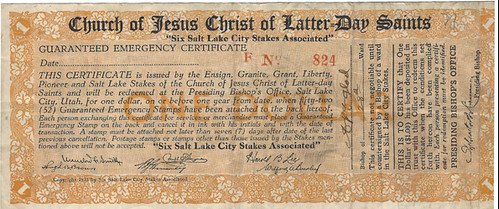
Money substitutes, such as this piece and a host of others, served the public by providing a circulating medium when banks all over were closed. The stamp scrip idea was used in many areas around the country. At times it worked well, but at other times it was not so successful. Apparently it was accepted well enough in Salt Lake City as evidenced by the stamps covering the entire back of this certificate.
To read the complete article, see:
Mormon church issued money substitute scrip
(https://www.numismaticnews.net/article/mormon-church-issued-money-substitute-scrip)
Royal Canadian Mint Peace and Liberty Medal
The Royal Canadian Mint has issued an ultra-high relief medal featuring designs from from lead engravers of the RCM and U.S. Mint. Here's a story from Canadian Coin News. -Editor

The 2019-dated “Peace and Liberty” medal featuring a reverse design by retired Royal Canadian Mint Senior Engraver Susan Taylor and an obverse design by 12th Chief Engraver of the U.S. Mint John Mercanti was recently released.
Taylor is the winner of the 2016 American Medal of the Year Award and the designer of the International Art Medal Federation 2018 Congress medal.
Mercanti is known for his designing more coins and medals than any other designer in U.S. Mint history; this includes the “American Eagle” silver dollar reverse.
To read the complete article, see:
New medal unites well-known Canadian, U.S. engravers
(http://canadiancoinnews.com/new-medal-unites-well-known-canadian-u-s-engravers/)
Royal Mail Withdraws D-Day Stamp
Arthur Shippee passed along this BBC News piece about a design snafu with the Royal Mail. This sort of thing happens all too often. Who's checking the work of coin, stamp and paper money designers? The internet makes it all too easy to very quickly find totally wrong information. -Editor
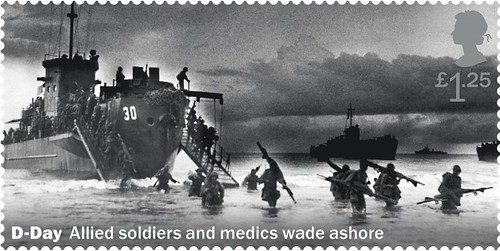
Royal Mail has withdrawn a stamp design marking the 75th anniversary of D-Day - after BBC News pointed out it showed US troops landing in what was Dutch New Guinea, nearly 8,500 miles from France.
The stamp was due to be released next year in a "Best of British" collection.
Captioned "Allied soldiers and medics wade ashore", it was said to depict the Normandy landings but was actually taken in what is modern-day Indonesia.
People who saw the error in a social media preview called it "embarrassing".
The image appears on the American National WWII Museum website, attributed to the US Coast Guard, and is said to show troops carrying stretchers from a landing craft at Sarmi, Dutch New Guinea on 17 May 1944.
To read the complete article, see:
Royal Mail criticised for D-Day stamp mix-up (https://www.bbc.com/news/uk-46694509)
FEATURED WEB SITE: WATERLOO COIN SOCIETY
This week's Featured Web Site is the Waterloo Coin Society (WCS). The image is from Canadian Coin News.The purpose of the Waterloo Coin Society (WCS), which was founded in 1959, is to encourage and promote the collection and study of coins, tokens, paper money, medals, badges, trade money, and other currency related collectibles; to cultivate fraternal relations among collectors; to encourage and assist new collectors, with special consideration to Junior Members; and to acquire and dispense numismatic knowledge.
The WCS is based in the heart of South Western Ontario and meets year-round on the second Tuesday of every month at 7:30 p.m.
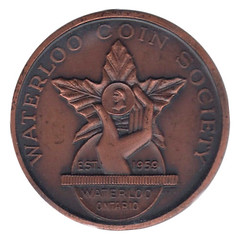
www.waterloocoinsociety.com

